If you would like a printed copy of any of our back issues, then they can be purchased on Farm Marketplace. You can also download the PDFs or read online from links below.
-
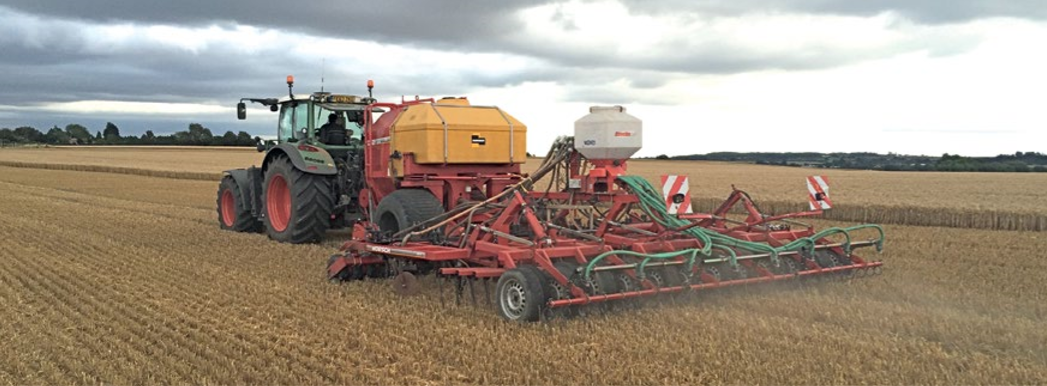
How To Start Drilling For £8K
Clive Bailye’s seed drill of choice is his 6m John Deere 750A , which has been used exclusively for 3-4 seasons. Last year, with an increased acreage, the founder and publisher of this Direct Driller magazine thought a second seed drill was necessary. Having just the one machine was a risk and in a difficult season would mean drilling was delayed. He looked around and found a good condition Horsch CO6 tine drill advertised in Germany.
Words and pictures by Mike Donovan
After delivery he rebuilt the coulters to a narrow profile so as to reduce soil disturbance. He says the tine drill is very useful driling after straw crops such as osr and also through the straw on second crop cereals.
Buying the drill from a German farmer was not particularly complicated, and provided him with a higher spec machine than Horsh sell in the UK. The seed dart tyres are much wider, and the machine is fitted with blockage monitors as well as full width front packers and also a liquid fert application system.
A sheaf of photos were taken, and Clive then asked for some of specific parts to show wear. The deal was done at under £5,000 which Clive says is the market value of these machines which are too large for small farmers to buy. Original owners like to buy new and sell when the machine is still in good condition.
Narrow tines with wear tiles
@Clive knew he wanted to make changes, substituting the Horsch tines and coulters for something far narrower, and has ended up getting his own design of tine made, which has a wear tile made from Ferobide, far harder than tungsten. The drill is on the farm primarily for osr and 2nd crop cereals drilled into chopped straw and the 25cm spacing is okay for these crops.
Comments on Clive’s on-line forum, TFF, said the drill many not be so good with beans, as the slot is a mere 12mm wide. And in barley the spacing may well be too wide as it needs to be thick. Clive points out that the seed pipe can actually be a bit wider than 12mm as it is in the shadow of the point. It would be good to have the option of using it for beans.

Above left: The cheap CO6 is being calibrated ready for its first outing

Above right: The adapted Horsch is being filled by the home built drill logistics trailer with seed and liquid starter fert.
Getting around the German instructions
The Horsch came, of course, with a control box and instructions in German. More on-line discussion revealed that English instructions were available on the Horsch website, and another explained that Horsch was sourcing some of these parts from Agton in Canada anyway. Zealman from New Zealand explained that the button marked with callipers should be held down for around 5 seconds. The menu is where you adjust the tramline sequence, valve layout and row numbers.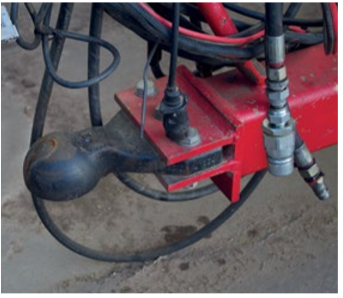
Ball hitch is a continental standard and provides a positive connection between tractor and drill

The Stocks Wizard has a rotor modified for Avadex which otherwise leaks everywhere
A Stocks Wizard is on the back of the drill and used for Avadex. Here again the knowledge of actual farmers is helpful. Alistair Nelson warned that the rotor and the surrounding shroud need to be changed, and he got good advice “from Rick at Stocks”. Clive has the same setup on the 750A and says that the Avadex leaks everywhere unless the modification is made. The drill was acquired and modified in 2016 and the results have been excellent.
The machine went through the residue without many problems and having the second drill has meant more timely planting. Clive has shown that moving into No-Till is not the expensive exercise so many farmers think it might be. The total cost, after modifications which included replacing all tines and coulters, was under £8,000.
Author Mike Donovan writes: we have featured a number of home made direct drills in @Practical Farm Ideas, and are always interested in seeing more. Please contact mike editor@farmideas.co.uk or 07778877514.
-
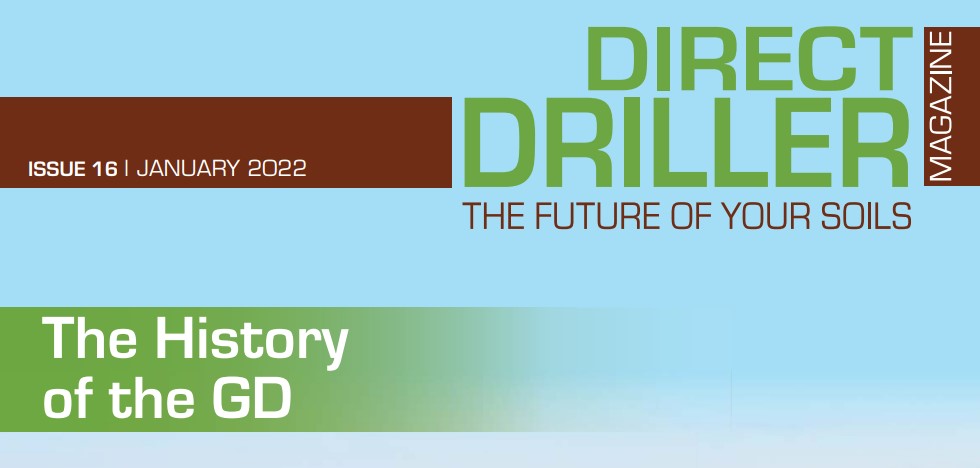
Introduction – Issue 16
Farming is not the only industry to face tsunami-sized variations in product prices and input costs. Think airlines, oil, retail, manufacturing, restaurants, hair dressers, theatres… I recently had a very interesting conversation with a very senior oil man who explained the hugely difficult and expensive process of shutting down a refinery and the equal cost of starting it up again. He said that Shell, his company, were employing advisors far more than ever before, as the challenges, and costs of wrong decisions are so high.
“We’re excellent at operating plant, but find a second pair of eyes from outside the business is well worth while when looking at the direction the company needs to be moving.” I translated it to farming, and the move toward No-till, and wondered how many farmers turn to a second pair of experienced eyes. Like the oil-man, the good farmer can be excellent at squeezing profit from a relatively static situation, but may not have the eyes which see woods rather than trees when it comes to the long term.
Do you go green and go with the flow, or be controversial and opt to continue focussing on production? If it’s production, the perceptive long term advisor might well focus on climate change and the possible shortage of water, while the farmer may look at a new harvester or some extra land, issues which are shorter term. Farm planning needs a view over the horizon which might appear some way off at present, but will as sure as eggs is eggs come all too quickly.
Finding an advisor with vision who looks beyond the present is difficult. Years ago the avuncular bank manager performed as general consultant, advising on loans and farm development, and they have largely been taken over by consultants who want to do indepth surveys, before hopefully reaching a conclusion.
A Happy Christmas to all Direct Driller readers.


-

The Face of Farming Leadership
Some people are born to be leaders, most just learn on the way. The latter seems to be how it works in farming. Our leaders are bred. Groomed though various roles to be the right mix of farmer and business we need to represent us. I’ve had the pleasure in meeting some of the spokespeople of farming in the UK and very few strike me as born leaders. The born leaders are the one’s that inspire you being around them.
For instance, Minette is a brilliant public speaker, great on the TV and the perfect face of farming. Which is exactly what she needs to be as the public head of the NFU. Never has farming needed a presentable and eloquent public face as much. Minette deals with news presenters’ questions and vegan activists with exactly the articulacy we need. I doubt she inspires many farmers, but that’s not her job in my opinion. A job which I hope she keeps for a while longer and I’m sure she will just get better and better at. But she doesn’t lead the NFU. She represents it.
Who are our leaders then?
Jim Mosely CEO of Red Tractor, Nichols Saphir is Chairman of AHDB, Professor Caccamo is CEO of NIAB. It’s not them and we shouldn’t be looking to them. They organise and control, not lead. It’s certainly not the politicians or wannabe politicians. All of them are paid to do a job and after enough years of that, they seem to care more about the next role than the cause. The merry go-round of civil servants in our industry is blatantly wrong. Although it’s nice to see so much new blood coming in at AHDB from outside farming. Our leaders are the ones that make their voices heard and give their opinion.
Those that are both doing and talking, where farming is still more of their role (neatly ruled myself out there). There are so many examples, the farmer focus writers in this magazine, YouTubers, farmers doing their own farm tours, the speakers at Groundswell, the NFU county chairs. You have met so many of them and they have inspired you. They don’t claim to lead our industry, they just do. You have listened to them and acted on what they say. You have absorbed and learnt from them. That’s what leaders do.
Farming has plenty of leaders, they just aren’t who you think of when you say “leader” out loud.


-
The 8TH World Congress On Conservation Agriculture
The Future of Farming: Profitable and Sustainable Farming with Conservation Agriculture
Held virtually in June 2021 in Switzerland and attended by 783 participants from farmer associations, international organisations, scientific institutions, private sector, non-governmental and civil society organizations, from more than 108 countries, from the developed and developing world. The main objective of the 8WCCA was to celebrate the Conservation Agriculture Community’s success as the driver of the biggest farming revolution to have occurred in our lifetimes, and to build on this and boost the quality and speed of this transformation globally towards sustainable agriculture in support of the Sustainable Development and the international climate goals.
Naturally grown soil is a limited, scarce, non-renewable resource. It is the base for the production of healthy food and native wood, a buffer element for the global hydrological cycle, filter substrate for clean drinking water, global carbon store, habitat of a huge biodiversity and element of attractive landscapes. At the interface of atmosphere, hydrosphere and lithosphere, the soil fulfills indispensable ecological, economic and social functions. The future of the world’s food security requires soils which are unpolluted, of stable structure and productive, in short – a sustainable soil use. Conservation Agriculture (CA) and its many locally adapted variants offer the best means of using soils for productive farming while enhancing their ability to fulfil their vital societal and planetary functions.
Accumulated positive experiences and scientific knowledge about Conservation Agriculture (CA) are leading to its rapid adoption world-wide. Farmers now apply CA on over 200 million hectares (15% of the word’s annual cropland area) in over 100 countries across a diverse range of agro-ecological zones and farm sizes, in all continents but particularly in Africa, Asia and Europe. It has enhanced farm production and reduced costs while conserving and enhancing the natural resources of land, water, biodiversity and climate.
In contrast, conventional tillage practices are not ecologically sustainable since they degrade land by destroying soil structure and biodiversity, reduce soil organic matter content, cause soil compaction, increase run-off and erosion and contaminate water bodies with pollutants and sediments, threatening land productivity, environment and human health. In addition, they produce unacceptable levels of greenhouse gas emissions, speeding up climate change. World-wide, they have accelerated degradation of many natural ecosystems, decreased biodiversity and increased risks of desertification. CA avoids many of the negative consequences of conventional tillage agriculture by replicating natural processes through the continuous avoidance of soil tillage, permanent maintenance of a soil mulch cover through which diverse crops are directly seeded or planted and rainfall can enter the soil and be retained, cutting erosion.
CA enhances the crop root environment (soil structure, carbon, nutrients and moisture) and cuts the buildup of pests and diseases. 2 In these ways, CA results in a productive agriculture for food security and improved rural livelihoods, especially women’s welfare since they provide a high proportion of agricultural labour. Its many economic, social and environmental benefits justify a fundamental re-appraisal of common farming methods. This Congress has confirmed that CA is here to stay. It has shown that the CA Community is in very good health, full of energy and new ideas. It has confirmed the validity of the Community’s way of operating, with farmers in the driving seat, innovating, sharing experiences, spreading the word and creating demands for supportive services from the public and private sectors.
All of us who have participated feel proud of our Community’s achievements and are determined to do everything within our power – and working with others who share our determination – to contribute to the emergence of a truly sustainable future of farming worldwide. We are confident that the millions of CA farmers whom we have sought to represent here will echo our commitment. We call upon politicians, international institutions, environmentalists, farmers, private industry and society as a whole, to recognise that the conservation of natural resources is the co-responsibility, past, present and future, of all sectors of society in the proportion that they consume products resulting from the utilization of these resources, noting the increasing interest in plant-based diets to improve human and planetary health.
Further, it calls on society, through these stakeholders, to conceive and enact appropriate longterm strategies and to support, further develop and embrace the concepts of CA as a fundamental element in achieving agricultural-related Sustainable Development Goals including those with a social and economic perspective, and those of ensuring the continuity of the land’s ongoing capacities to yield food, other agricultural products, water and environmental services in perpetuity. It follows that the environmental services provided by farmers who nurture soil health should be recognised and recompensed by society.
Action plan
The Congress participants declare their commitment to engage the CA Community in achieving the following goal and to taking the actions needed for this.
Goal
Given the urgent need to accelerate the global move to sustainable food systems, and in particular to respond to the global challenge to mitigate the advancing climate change, the Congress agreed that the CA Community should aim at bringing at least 50% of the global cropland area or 700 million hectares under good quality CA systems by 2050. These holistic CA systems would involve CA farmers in engaging progressively in the full array of sustainable approaches to farming, adapted to their ecological and social conditions so as to maximise the sustainability benefits of growing crops without tillage.
Practical actions
To achieve the goal, a massive boost should be injected into the momentum of the CA Community’s activities with a concentration on the following six themes:
1. Catalysing the formation of additional farmer-run CA groups in countries and regions in which they do not yet exist and enabling all groups to accelerate CA adoption and enhancement, maintaining high quality standards. 3
2. Greatly speeding up the invention and mainstreaming of a growing array of truly sustainable CA-based technologies, including through engaging with other movements committed to sustainable farming.
3. Embedding the CA Community in the main global efforts to shift to sustainable food management and governance systems and replicating the arrangements at local levels.
4. Assuring that CA farmers are justly rewarded for their generation of public goods and environmental services.
5. Mobilizing recognition, institutional support and additional funding from governments and international development institutions to support good quality CA programme expansion.
6. Building global public awareness of the steps being taken by our CA Community to make food production and consumption sustainable.
In order to facilitate the implementation of above thematic activities, the Congress endorses the need to:
(a) operate the Global CA-CoP as an independent non-profit mechanism, with ongoing hosting support of ECAF and patronage by FAO, and with an advisory panel, and authorised to set up task forces and working groups to help implement the priority practical actions;
(b) strengthen the CA-CoP Moderator capacity within the CA Community;
and (c) create a CA Hall-of-Fame in time for the 9th Congress.
It would also oversee and support future processes for convening CA World Congresses. The Global CA-CoP would require a permanent IT systems development and operating capacity, with sound financial management, programme monitoring and reporting capacities.
The Congress participants feel confident that much of the extended moderation function can continue to be provided by CA Community participants who are willing to provide their time, knowledge, expertise and energy on a voluntary basis. This Congress has reinforced our conviction that it is entirely possible to meet the global goal of making our food systems sustainable in every sense of the word and that our Community has a vital role to play in this transformation. Our own experience shows that farming can quickly respond to new challenges when farmers see that these are in their own interests.
Our aim is to engage our whole Community as quickly as possible in creating and spreading optimal and profitable low-input, high-output CA-based farming systems that are dependent on biological forms of crop protection and plant nutrition management with maximum energy efficiency and minimal use of externally sourced inputs. This approach shows our commitment to making all we do together in future still better than what we now do! We pledge to work at all levels with all who share this vision of farming for the future, seeking their guidance and sharing what we learn with them. And we will also partner with those who champion complementary changes in downstream elements of the food chain to bring to healthy nutrition for all people and the elimination of food waste.
Healthy soils are the very heart of healthy lives and a healthy planet!
-
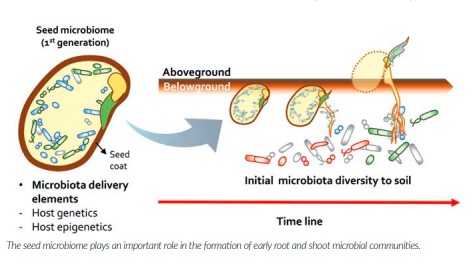
The Seed Microbiome
Written by Joel Williams
In the last article we introduced the various habitats that exist on and within plant tissues where a range of microbes coexist with plants and provide many benefits to growth and development. Despite the majority of microbiota living around plant root systems, there are also a range of microbes that also uniquely associate with plant shoots, leaves, flowers or seeds; and we are only just beginning to understand their importance. In this article we will take a closer look specifically at the seed microbiome and explore some of the factors that shape this biome and how this can be of benefit toward a more sustainable agriculture.
Like many other examples in agriculture where we have tended to focus on the negative, the prevalence of pathogens on seeds has been extensively studied and has dominated much of the thinking regarding seed microbiota. However, the occurrence and role of other beneficial microorganisms – which constitute a majority of the seed associated organisms – are relatively unknown. Seeds generally present similar proportions of bacterial and fungal diversity, which contrasts with other aboveground plant compartments that are for the most part, highly dominated by bacterial diversity. Microbial communities associated with the seed coat are usually more diverse than those associated within the seed – only a smaller number of specialist microbial species have the ability to pass through the external barriers of plant tissues and colonise tissues within; most others can only associate with the external surfaces.
In the same way that there are unique and distinct microbes that associate with different plant parts, there are also specific microbes that associate exclusively to distinct micro-habitats of the seed itself. There are three seed compartments where microbes associate – the embryo, the endosperm and the seed coat. Seed-associated microorganisms can be acquired either ‘horizontally’ from various and local environments (e.g. air, water, insects, seed processing) or ‘vertically’ passed down from the mother plant, and hence, transmitted across multiple generations. Overall, microbes associated with the embryo and endosperm (internally) are more likely to be transmitted vertically than those associated with the seed coat, these being mostly transmitted horizontally.
Three main transmission pathways have been documented:
1. The internal pathway – whereby microorganisms colonise developing seeds via the xylem or nonvascular tissue of the mother plant.
2. The floral pathway – whereby microorganisms colonise developing seeds via the xylem or nonvascular tissue of the mother plant.
3. The external pathway – that represents microbial colonisation of developing seeds through the stigma.
Of course, the development and application of the majority of seed treatment technologies have focussed primarily on the external pathway. Some of these inoculants are designed to remain on the outside and colonise the roots as they develop while some are destined to become endophytes and enter the plant tissues (such as rhizobia or some mycorrhiza for example). The exact mechanisms which determine the final structure and composition of the seed microbiome are still being elucidated but factors that influence this include a range of environmental conditions, soil type and perhaps most importantly, the host plant itself plays a major role in shaping its seed microbiome.
It is now understood that each and every plant species recruits and structures a microbiome unique to that species (referred to as its core microbiome), and even going beyond this, different varieties also shape their own ‘varietal specific’ microbiomes. These kinds of insights are opening some fascinating doors to understanding the species specific nature of plant-microbe interactions, which in the future will no doubt help design efficient production systems whereby plant varieties and microbial strains are highly aligned and optimised for various outcomes (plant health, pest resistance, nutrient use efficiencies etc). Although I fully support the use of highly diverse, broad spectrum and DIY inoculants like compost extracts, there are many examples whereby successful suppression of a pathogen (for example) is dependent on a specific antagonistic mechanism from one particular microbial species (or even strain); so illuminating some of these highly specific crop-microbe interactions at the molecular level will be a fruitful endeavour in years to come.

In the meantime, it is clear that the seed microbiome is of utmost importance to plant development – affecting growth, drought resistance, disease resistance and even flowering times. We know the seed microbiome becomes active immediately after sowing as the germination process begins. These microbes associated with the seed are the early risers so to speak and consequently play a key role – somewhat as gatekeepers – in safeguarding the seed and communicating to the rest of the soil biome and shaping which organisms from the soil can or can’t subsequently colonise the seed and the emerging roots and shoots.
This early structuring of the microbial community that subsequently colonises the plant can have major and long-lasting implications on how the root and shoot microbiome matures through the rest of the plant developmental stages. There are major knowledge gaps on the impact of fungicidal seed dressings on the nontarget organisms of the seed microbiome. We can safely assume that at least some beneficials will be compromised but whether the use of such inputs may be leading to negative consequences – such as greater disease susceptibility – in later crop stages remains to be studied. Even less understood is whether fungicidal dressings may be impacting the composition of the seed microbiome that is subsequently inherited from the mother plant to the next generation and hence inducing transgenerational changes in the seed microbiome over time.
Practically speaking, there are 3 take homes we can draw from these insights.
1. Eliminate the use of fungicidal seed dressings – if this idea is too daunting for you, start small. Choose half a field or a few tramlines and start the process on a small scale. Observe as you go and scale up in stages that are comfortable within your attitudes to risk.
2. Substitute dressings with bioinputs – rather than just cut out dressings, it really is preferrable to substitute the chemical with other biostimulants or bioinoculants. These could also be applied to the seed or injected into the furrow where possible. Input substitutions might include humic acid, fish hydrolysate or molasses along with some kind of microbial inoculant such as compost extracts or commercial products.
3. Save your own seed – considering that part of the seed microbiome is inherited from the local environment (mostly the soil), saving seed from plants that were grown in your soil is potentially optimising the microbiota that associate with your seeds to your specific soil type, growing conditions and management practices. There is still much to learn regarding these potential transgenerational effects but early indications suggest this is worth pursuing.
References
1. The variable influences of soil and seed-associated bacterial communities on the assembly of seedling microbiomes. (2021). doi:10.1038/s41396-021- 00967-1.
2. Seed microbiota revealed by a large-scale metaanalysis including 50 plant species. (2021). doi:10.1101/2021.06.08.447541.
3. Plant Communication With Associated Microbiota in the Spermosphere, Rhizosphere and Phyllosphere. (2017). doi: 10.1016/ bs.abr.2016.10.007
4. Inheritance of seed and rhizosphere microbial communities through plant–soil feedback and soil memory. (2019). doi: 10.1111/1758- 2229.12760
5. Revisiting Plant–Microbe Interactions and Microbial Consortia Application for Enhancing Sustainable Agriculture: A Review. (2020). doi: 10.3389/fmicb.2020.560406
-

History Of The GD
Written by Tony Gent
With over 60 years of farming, I have seen and been involved with so many changes, as a lad from working with horses and leaving school at 15 to working on my father’s smallholding with only 50 acres and a mix of cropping. The farm began to mechanise and expand, so did my interest in designing better tools, particularly to improve soil management. The need to produce crops in an economic and competitive way has always been my driving force, with the sustainability of the business as well as ecology and the environment.
We first started to notice the importance of soil condition in the 1960s, with taking on heavy distressed soil which was suffering from poor cultivation techniques, resulting in pans and compacted layers. Having mastered those problems it became obvious that moving soil around was not only complex and expensive, but the soil workability was deteriorating and more liable to slump, cap and puddle.
At that time larger more complex machinery was becoming available and seen as a major part of the solution. To take advantage of larger tractors, particularly tracklayers with threepoint linkage and larger 4-wheel drive in the 70s my first development was what became known as the “Wilder Pressure Harrow”, my own design of harrow which was manufactured and marketed by John Wilder Engineering. This consisted of ground following individual units mounted on a parallel linkage, pressurised by a floating hydraulic down force and tines that could be infinitely adjusted. This allowed the scrubbing frame to achieve a precise seed bed for both spring use, on overwintering ploughing and on heavy tined cultivation in the autumn. The Pressure Harrow was awarded a silver Medal at the Royal Agricultural show in 1977 for machinery innervation.

With much more emphasis on autumn crops, especially oilseed rape and September establishment of wheat, the Pressure Harrow became invaluable for scratch tillage that was widely adopted. However, to fight soils that were in a poor structural state causing rooting and drainage problems a means of lifting and shattering the soil with minimal surface disturbance was needed. Together with Ken Taylor a local agricultural engineer a low disturbance subsurface tine was developed. This featured a slender point and front shin together with large wings to shatter the soil with a wide lateral effect, allowing wide tine spacing. It achieved the effect of loosening all the soil with no layer mixing or bringing unwanted soil to the surface. It became known as the “Flat Lift”
Demand for this method of low disturbance soil loosening coincided with larger horsepower, mostly American, tractors becoming available and to meet the demand for the Flat Lift an engineering company was founded to manufacture and to market it, an agreement with Parker Farm equipment was put place with the product being known as “Parker Farm Flat lift” manufactured by Taylor-Gent Engineering. However, as others adopted this approach competition from more established companies became intense, and as a small specialist manufacturer it was not viable. The rights to the product were acquired by Spalding’s, who still market it as the original “Flat Lift”
There was no-doubt we were on the right lines with all this. However, the whole process had to change as attitudes to straw-burning changed in the early 90s. We had become experts at this, using combines fitted with spreaders to achieve a 100% burn, completely obliterating trash with no chemical help such as glyphosate. However, as autumn cropping became more common, the intensity of the burn inevitably led to straw-burning being banned, and it almost seems incredible now this practice lasted so long. Although we now realise what we thought was an idyllic situation, but with the first signs of chemical resistance creeping in especially with black grass and brooms we now realise this was an unsustainable situation.

The straw burning ban was a massive game changer, as we were growing lots of second and third wheats that were early drilled, producing high volumes of straw to deal with. We had to revert to moving soil around with some inversion or mixing to bury or at least incorporate the straw to some degree. This caused a massive reinvestment in machinery and power to rapidly recover aggressively moved soil into a suitable seedbed in a very short time.
During this period, we took advantage of land becoming available with rapid expansion in acreage. Much of this was again soil in a distressed state requiring lots of TLC. Also, with the new FBT and contract farming arrangements with strong competition the rents tendered subsequently proved to be far too high. We had no choice but to invest in lots of power and big soil moving and drilling kit. Due to our limited cash resources and our ability to mend and make, this was done with a focus on quantity rather than quality. At the end of this period, we owned 3 CAT Challengers and a full set of the kit to utilise them that was rapidly becoming very tired.
Into the 2000s now farming a large area, costs were rising, and we were in a period of low commodity prices with wheat as low £60 to £70 per ton and locked into historic rents that were proving unsustainably high. This all came to a head in the years 2004 to 2008 when we knew we would need to re-invest in newer machinery. Given the intense workload and poor margins, with no prospect of improvement this seemed a questionable investment and caused us to re-evaluate what we were doing.
It was at this time I had a chance coming together with the UK No-till pioneer Tony Reynolds. I was NFU County Chairman and he became my Vice Chair. Many of our NFU meetings would end in discussion around soils, much to the disquiet of some. This resulted in several visits to his farms to get an understanding of what he was doing and above all to tap into his knowledge and experience and gain confidence to try it for ourselves. Subsequently also becoming involved with experiences of the Europe wide ECAF (European Conservation Agriculture Federation) which he is part of.
We began to move towards a change in 2007 with the first wheat being established with the Vaderstad Rapid drill after a light scratch to allow the conventional light discs to penetrate undisturbed soil. This first year with wheat it was a success and very encouraging. We also attempted oilseed rape sowing with a hired Bertini drill into a heavy surface residue situation in wet conditions. This was a total failure due to slugs, hair pinning and toxin damage.
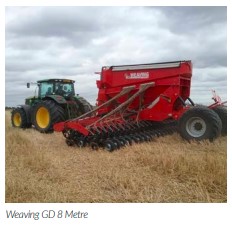
Drilling kit for No-till was somewhat limited at the time, and with our soil conditions resulting in producing large broken out clods with a solid tine and potentially high residue we felt we must stick to a rotating disc. The options were basically only Bertini or John Deere.
At that time, I was invited to Argentina to visit the Bertini factory in Rosario and attend the Expoagro Farm Show, where I found lots of Notill kit of various designs and creations, mostly very basic or locally specialist. It had the feel of being built in the farm workshop or by the local blacksmith, not at all to European standards except for a few more serious manufacturers like Bertini. Argentina was forced into No-till by economic pressures of direct commodity taxation forcing massive simplification with cultivations resulting in cost cutting. They had been advised that as result of this they would suffer approximately 20% yield loss, but the reality was after 5 years their yields were actually greater as a result of adopting Notill. Their perception, probably correct of Europe was that we were given so much financial support that we didn’t need to consider costs and we just wasted money on lots of complex kit with shiny new paint. I came home with what seemed to me a simple thought that if I pursued their logic of production methods, together with the benefit of the support it would be a win-win situation and basically that is what happened.
To make a solid start we needed to jump in, and the first necessity was a drill. Having seen both the Bertini and the John Deere in action, I liked the double disc system of the Bertini with its slender opening, low disturbance and so returning from Argentina I came close to placing an order for an 8 metre Bertini. However, considering that it was a box, end tow for transport drill and having experienced and seen its limitations in our wetter conditions thought better of it. So, to get us going a new John Deere 6 metre 750A was ordered for the 2008 autumn season to work alongside our team of Challengers and conventional 8 metre Vaderstad.
For this season all the rape was very successfully established, wheat direct drilled after Beans and some second wheat with the John Deere. With the second wheat we had an interesting and revealing comparison: our standard practice for a second wheat then was to plough followed by a press and then to aid weathering mostly the need for a second press with tines. At drilling three CAT challengers were in action with a primary seedbed cultivator, followed by a power harrow and then the 8 metre Vaderstad and then having to be rolled, 6 or 7 operations in total. I remember in one situation I was drilling a next field in the same rotational situation with one pass with a 150hp tractor and the new John Deere 750A. The No-till crop established well and became a robust crop and out yielded the conventionally established crop.
With this first year experience our direction became cast in stone from that point on and we began disposing of the now unwanted tractors and machinery, eventually resulting in the removal of a 1000hp from our system. By 2009 we were fully committed to No-till but in the subsequent years it was by no means plain sailing: and sometimes conditions weren’t exactly favourable, experiencing wet seasons and degraded soil that needed time to recover.
I felt that the compromise I had taken opting for a single disc drill was starting to show and began to reflect back to my observations with the Bertini double disc with much less disturbance of the opening and a kinder soil action. I became aware that Weaving Machinery were seeing opportunities in the No-till marketplace and revamping their Krause system into what became known as the Big Disc, of which we acquired an 8 metre version. It consisted of a double disc arrangement of a small disc running in the shadow of a larger disc thereby creating a very narrow opening, but the opening still had to be closed which was difficult in dry hard conditions and was only achieved by pressing and squashing in wet conditions. The problems were because of the unbalanced side pressures of large and smaller disc the rigidity of the linkage required the same robust construction that was needed with a single disc, and that was its failing which limited its effectiveness.
The breakthrough came with a passing comment from Tony Reynolds that if it was possible to cut into the soil at an angle to place the seed under a lip of soil it would be much easier to close the soil over the seed. The problem was how in practice to achieve this. My first indication of a possibility along these lines was becoming aware of the Canadian Saskatchewan “Barton Opener” which is a single angled undercut disc system. However, subsequent investigation found that it had limited minimal disturbance and seemed to have technical limitations with stability robustness.
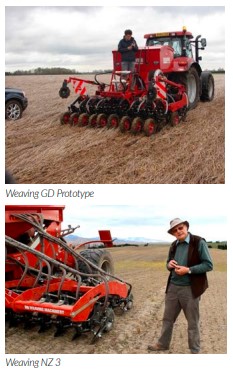
I began to realise that to achieve stability with a disc system, the force of moving soil to create an opening needed to be countered by a stabilising force on the same bracket. I began by taking the standard Weaving Big Disc arrangement and hinging it on an angled pivot to create a neutral trailing action. I then gradually increased the angle from vertical to approximately 20° to 25°. This achieved the undercut angle I was looking for with the smaller disc on the upper side creating a wave of soil flowing over it with the rotation forming an opening with very little soil disturbance, damage, or side compression due to the soil being gently eased upwards. The larger disc formed the initial soil cut, helping with a precise and slender opening for the seed. The main benefits are that an opening is created to place the seed in the soil without having to move the soil sideways, so there is no requirement to return the soil back to cover the seed. It was often described as like lifting the edge of a carpet and placing seed under it and it then returning to position covering the seed (see attached photo of an early demonstration unit)
Weaving Machinery quickly saw the potential of the system and a manufacturing and marketing deal was agreed and production began in 2015. The GD (Gent Disc) drill quickly became extremely popular in the UK, many European countries and subsequently New Zealand.
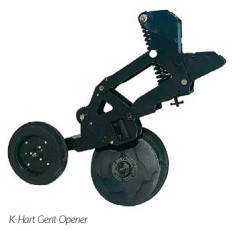
Later that year I visited Australia and picked up a contact I had made with the famed Bill Crabtree “No-Till Bill” in Western Australia. He introduced me to Darryl Hine of Direct Seeding and Harvesting based in Albany WA. Darryl was one the leading exponents of introducing No-till machinery to Australia and was the importer and agent for the Canadian K-Hart range of disc drills.
With introduction from Darryl, I then visited K-Hart at their premises in Saskatchewan, where I stayed for a few days with farmer and engineer Kim Hartman getting to know them and their product which was similar to Weaving’s and consisted of a conventional double disc system. We did some trials with some Weaving GD Units that had been sent to them, which they were impressed with and quickly saw the potential. Again, a deal for manufacture and marketing covering North America and Australia was put in place and with some redesign to adapt to their standard parts production began of the “K-Hart Gent Opener” in 2017, with modifications to the design to suit their conditions both in North America and Australia. I have subsequently visited both Canada and Australia to help with further design refinements and promotion of the opener where interest and sales are rapidly increasing. K-Hart has now evolved into an expanding company involving a new team to design and develop a specialist unique frame to suit the “Gent Opener” branded the “Spider” frame. These frames are up to (76ft) 24 metres wide which folds in 5 sections and have typically 100 to 130 openers.
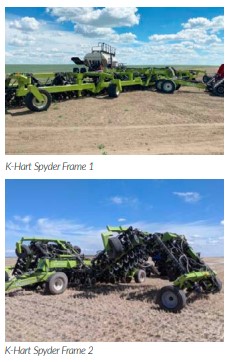
Our farm has now been No-till for 12 to14 years and we have absolutely no regrets. As envisaged in the early stages, it has been a win-win situation of lower operating and input costs with sustained or improved yields. We now have a more sustainable rotation and massively improved soil with organic matter levels that started at near nil now close to double figures on many fields. The release of capital also allowed the business funds to invest in the massive expansion of a fledgling enterprise on the farm of Free-Range Egg production.
The transition from an intensive high input to a low input and much more rewarding and sustainable system has been a very interesting and a rewarding journey. New benefits are now emerging, with the demise of subsidy support on the horizon, addressing climate change and carbon sequestration. This latter opportunity has now been identified as an additional income stream that can help support and encourage more farmers in adopting No-till, so again we have a win-win situation.
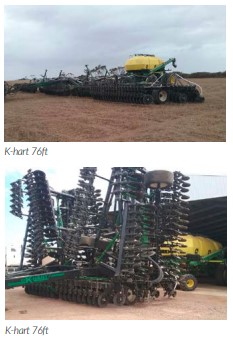

-
Welcome To The 8TH World Congress On Conservation Agriculture
Speech given by Professor Amir Kassam
Friends, This is an historic day for the CA movement. It was twenty years ago that ECAF, the European Conservation Agriculture Federation, organized the First World Congress on Conservation Agriculture in partnership with FAO. Today, thanks to continued support from FAO and ECAF as well as other sponsors and especially SWISS NO-TILL, we are gathered together here in Bern and all around the world to celebrate our success as the drivers of the biggest farming revolution to have occurred in our lifetimes. Let us celebrate our joint engagement and contribution to transforming farming from being the main source of land degradation globally, to becoming a driving force for conserving and rebuilding healthy soils and agroecosystems so that they can sustainably meet the world’s future needs for food and other farm products while helping to slow the pace of climate change and ecological breakdown.
Let us celebrate our part in the 2 transformation of farming, from being a contributor to the many interconnected crises facing the world, to being a key part of the solution. It is no exaggeration to claim that our achievement in engaging millions of farmers across every continent in what has become known as Conservation Agriculture – or CA – has been a massive game-changer. We can and should take great pride in all we have done but we still face huge challenges to complete our revolution so that what we have pioneered is steadily improved and becomes the global norm in farming. Our task during these 3 days on-line, and in the field days, is to shape the future directions in which we need to move together to achieve this in the shortest possible time.
For this, we must apply lessons from our collective experience over the past 50 years or so. We have come this far because of the foresight and determination of some remarkable visionaries and pioneers – mostly farmers – in the USA, South America, Asia, Africa, Europe and Australia. These pioneers saw that conventional tillage, involving frequent inversion of the topsoil, was damaging the structure of soils, reducing their organic matter content, and making them susceptible to erosion by wind and water. They showed us that we could grow productive crops without digging or ploughing, and they devoted their lives to improving 3 CA technologies and sharing them with others in their own countries and beyond.
Rather than list these pioneers by name, I invite each of you to think back to the beginnings of CA in your own country and to reflect on the exceptional people who challenged conventional wisdom and put their ploughs aside. One of the most notable of the early CA pioneers in the Global South was Dr. Herbert Bartz who sadly died recently. In 1972, with encouragement from Rolf Derpsch from GTZ, he became the first Brazilian farmer to throw away his plough. From then on, he devoted his life to improving CA techniques and promoting CA in Brazil and globally. Now, Brazil has become a leading CA nation with 43 million ha – or nearly 80% of its annual cropland – under various forms of no-till agriculture. Herbert was hoping to be with us today and had prepared a brief video message to inspire us to follow in his footsteps.
I am delighted that his daughter, Marie, has joined us in this Congress, and she will have more to say about her father this evening at the Social event where she will be showing the video. I invite you to watch another video now which Herbert made not long ago for a CA Congress in Africa. Let me now briefly touch on our achievements When the pioneers of No-Till said that good crops could be grown without digging or ploughing, most farmers laughed in disbelief and dismissed them as dreamers. Now, just half a century later, millions of farmers all over the world have taken them seriously. They have embarked voluntarily on all kinds of CA systems, no longer carrying out any tillage on their farms. The global area farmed using CA systems has risen from less than 1 million ha in 8 countries in 1970 to 205 million ha in 102 countries in 2019.
This is 15% of the world’s cropland area. In Argentina, Australia, Brazil, Canada, Paraguay, South Africa, Uruguay and the USA, CA methods are applied on more than half their cropped area. From 1990 to 2009, the CA area globally increased at an average annual rate of 5.2 million ha, reaching about 100 million ha in 2008. From then on until now, the CA area expanded at double that rate, attaining an average of 10.5 million ha per year. This was largely because the global CA Community of Practice (CA-CoP) was established in 2008, with its own communication and 5 networking platform, and began to globalize CA through the farmer-led CA movement worldwide.
The CA-CoP, of which I am Moderator, is a fast-growing openended community in which any person or institution interested in CA is welcome. While its network and mailing lists extend its reach, it has no list of members, no membership fees, no hierarchical structure and no officers with executive powers. It is glued together by its adherents’ commitment to farming without soil tillage, their natural inclination to innovate and their enthusiasm to share their experiences. This has led to the formation of many local CA groups which, in turn, are linked to regional groups in regular contact with the Moderator.
With the valuable patronage of FAO and much goodwill and support from other international entities, the Global CA-CoP has come to play an important catalytic and facilitating role, including the promotion of regional programmes and national activities, sharing experiences, making information, especially on innovations, widely accessible, and engaging donors and financing agencies in funding local CA programmes. All of this has been done with the intent that farmers remain in the driving seat. The triennial Congresses provide the opportunity for all interested parties to take stock of progress, to share experiences and ideas, and 6 to chart the future directions in which the Community will seek to move.
This has clearly succeeded! CA is now practiced in all major climate zones in which there is farmed land – from the warm humid tropics to the cool temperate areas. And it is applied in all the world’s main farming systems. It has taken hold in rainfed and irrigated areas, short-term and perennial crops, mixed crop-animal farms and organic systems. It has been adopted by large-scale mechanised farms and by smaller farms where most of the work is manual. CA has also evolved into a wide range of complex farming systems which make the most of the improved soil conditions created by the absence of tillage. But in spite of all of this, our movement remains vulnerable to possible changes in the governance of our global food system.
A surprising threat could come from transnational corporations, convened by the World Economic Forum in Davos, which have declared a 4th industrial revolution. This would be based on harnessing ‘big data’ to tell every farmer what to grow and when to plant, and to manipulate consumers’ food choices. While they claim that this will cure the ills of the global food 7 governance system, I feel bound to ask: Will this address degradation of our common resources and the planet? Will this meet the needs of small-scale farmers and protect their seed, land and food sovereignty?
Will this change our food distribution system to a more equitable one that would eliminate hunger and lead us to healthier diets? In raising these questions, I am not denying that there are many valuable opportunities for widening the use of digital tools to empower farmers and consumers to make better choices – but without infringing on their rights to make their own decisions.
The reality is that we are the great farming revolutionaries of our time for large- and small-scale farmers. Together, by translating our knowledge and convictions into practical action on the ground, we are leading the most transformational revolution in how land is farmed since the inversion plough was invented in the mid-17th century.
We have successfully challenged the universally held assumption that most land has to be regularly and intensively tilled and chemicalized to be productive and profitable. We are also proving that the widely held view that smallholders have no future is nonsense. We do this because we believe in it, based on the evidence generated by the early no-till farmers. Nobody 8 has had to order us to stop ploughing and digging and nobody has had to pay us to change our ways! Farmers are the initiators and drivers of the CA movement, its main innovators, and its main promoters.
Their success, including spreading and adapting CA into new ecologies and farming systems, has led to the growing involvement of scientists and created a demand for specialised equipment and inputs that has expanded the participation of the private sector in our revolution. The main motivation for farmers’ engagement has been CA’s potential for net gains in productivity and incomes. By eliminating tillage, larger farmers have cut spending on farm machinery, inputs and fuel, while small-scale farmers have not only made big savings in time and human energy from excluding deep hand-digging, but they have also found that they can move into CA with few purchased inputs and rely on their own seeds.
Formal research systems have become increasingly engaged in comparing the impacts of different CA interventions especially on soil structure and biology, moisture retention, carbon sequestration and pesticidefree weed and pestmanagement. There is now a huge raft of easily accessible scientific studies on almost every dimension of CA applications. Thanks to the expanding databases of CA networks, FAO and Cornell 9 University, information is easily accessible on almost every dimension of CA in text-books, and in scientific and technical studies. In future, however, researchers and farmers must do much more to team up in generating new CA systems knowledge.
One feature of CA is that its adoption and spread does not follow traditional linear agricultural extension models that transfer the findings of researchers to farmers. Instead, farmers themselves play the major role in innovation through CA Farmer Associations, Farmer Field Schools, Clubs and Networks as well as through community engagement. These social institutions offer opportunities for sharing knowledge and for cultivating solidarity that stimulate change and self-empowerment. This works effectively for all farmers when their skills, and needs for seed, land and food sovereignty are respected and supported by governments and stakeholders in the public and private sectors.
True, the private sector has responded well to demand especially for machinery and inputs, but in many places, CA farmers call the shots and the private sector has to offer a mutually beneficial service support along the value chain. 10 We are pushing ahead with CA and improving it as we go, mainly because we have found our incomes rising and the quality of our farmland improving. CA differs from the dominant ‘industrial’ approaches to tillage farming that have been driven by the goal of ever greater intensification, aimed at maximising yields.
They use more and more inputs and need ever bigger investments. Over time, they all too often damage or destroy the soils and environment that provide the foundations for food production and environmental or ecosystem services, and also put human health at risk of nutritional disorders. In spite of CA’s rapid spread, tillage-based agricultural intensification continues to cause vast physical and biological soil degradation and erosion, forcing the abandonment of once productive agricultural lands, increasing the frequency of flood damage, polluting our environment with toxic chemicals, releasing high levels of greenhouse gases, wiping out biodiversity, and reducing adaptability and resilience to biotic and abiotic stresses as well as fostering resistance to antibiotics. It seems to come naturally nowadays for humans, at least in so-called ‘developed countries’, to think that more is better.
We now realise that satisfying the desire for more and more material things without considering their environmental impact is putting at risk the future 11 of our children and grandchildren, and of all those with whom we share the planet. CA’s success comes from deliberately moving in exactly the opposite direction. We are getting more from less and bequeathing a healthier planet to future generations. We have already shown the ability of CA’s core practices of no-till, soil mulching and crop diversification to provide an effective foundation for integrated biological pest management and for drastically reducing agrochemical use.
We have also shown in several environments with smallholders and large-scale farmers the avoidance of the use of pesticides for controlling weeds, insects and pathogens through for example Push-Pull strategies, techniques of planting green involving green manure cover crop mixtures, and manipulation of soil fungi-to-bacteria ratios. And many smallholder farmers are practicing CA without the use of any agrochemicals. This is why FAO placed CA at the core of their ‘Save and Grow’ global strategy for sustainable production intensification. CA is good for all farmers, good for the land, good for the planet and good for people.
Let us now look to the future of CA There is no doubt that CA is a success story that is here to stay and that it will continue to grow fast. But what 12 about our expectations for the outcomes of this Congress? The organizers of the Congress are convinced that CA must be the mainstay of the shift that the world has to make urgently towards sustainable farming and food systems. This is because we know that, for as long as most soils continue to be damaged by tillage, the world cannot reach the goal of making food systems sustainable. But we also recognise that some aspects of No-Till systems, as they are now generally practiced, are restricting sustainability.
Specifically, some No-Till systems with poor cropping diversity still remain too dependent on pesticides (especially herbicides), on mineral nitrogen fertilizers, and on unduly heavy farm machinery driven by fossil fuels. I am sure that you will all agree that this has to change. Within our global Community there are many precedents for moves in the right directions, but we need to throw our weight behind accelerating their enhancement and uptake, so that CA becomes synonymous with sustainable farming for the future. We also know that we cannot go it alone. We must engage globally and locally with the champions of other 13 essential elements of sustainable farming, especially those engaged in organic farming, integrated pest management, agroecology and regenerative farming systems in their various guises.
In return, all these farming systems can be helped to harness CA principles and practices. If we do not share our experiences, help each other and pull together, many of the international Sustainable Development Goals – the SDGs – relating to food, natural resources management and climate change will be unattainable. We also have an important role to play in the recently launched UN Decade on Ecosystem Restoration 2021-2030. I also suggest for your consideration that the time may have come for our Community to begin to help to shape food consumption patterns in ways that will relieve pressure on the world’s finite area of cultivable land rather than destroy forests and other vulnerable ecologies to expand farmed land, with doubly negative effects on the rate of climate change.
Fortunately, we are faced with a win-win-win opportunity, as the area under farming can be greatly reduced, environmental damage curbed and human health improved by inducing a shift towards predominantly plantbased diets: this, in turn, would cut demand for livestock feeds which has been a main driver of the recent damaging expansion in cropped areas especially in tropical regions. 14 It is against this background that I suggest that this Congress may wish to signal its support for a notional goal of having good quality CA-based systems fully applied on at least 50% of the world’s annual cropland area or 700 million ha by 2050.
I believe this is an attainable goal given that the global CA movement doubled the rate of uptake of CA during the last decade. The big challenge will be to graft the other essential elements of sustainable farming into all our programmes – including those in the existing 200 million ha already applying CA. Achieving this goal would require a massive boost to the momentum of our Community’s activities with a concentration on the stated six themes.
To move forward with this, strengthening of the Moderator capacity within the CA Community is now needed. Much thought must still to be given to this, but one thing is clear: we must retain the concept that, as now, our future actions must be guided mainly by a growing team of volunteers coming from within our midst who are committed to giving their expertise, time and energy to enhancing and spreading CA systems. Earlier, I paid tribute to our pioneers and champions. With millions of farmers now applying CA in its many variants across the world, I feel confident that plenty of 16 people will signal their willingness to dedicate themselves to moving our activities forward.
One of the few positive by-products of the COVID pandemic is that it has stimulated great advances in information and communications technology. We are applying some of these in this largely virtual Congress. Any new actions need to take the fullest possible advantage of these innovations. One important implication is that all those involved in any new programme moderation arrangements can make most of their inputs from where they live. Of equal significance is the huge opportunity that these technologies offer for accelerating the spread of advances in knowledge across our Community and beyond.
The Community’s strength has been built on farmer-to-farmer sharing of experience, usually within their own localities and sometimes through country exchange visits. Now these farmer-to-farmer exchanges can instantaneously become global. And so, we shall nurture the emergence of a stronger moderating mechanism that will function almost entirely virtually. It would enjoy the guidance of an advisory panel, representing regional and national interests and those of cooperating institutions. It would have the capacity and power to set up task forces to 17 push forwards on each of the 6 main themes – and any more that might be added.
And it would need to have a permanent IT systems development and operating capacity. It would also oversee and support future processes for convening CA World Congresses. Finally, it would have to be set up as an entity – perhaps as a nonprofit organisation — with sound financial management, programme monitoring and reporting capacities. Finally, though this may seem a minor issue, I also propose that we convene a small working group to set up arrangements for honouring our pioneers through creating a CA Hallof-Fame in time for the 9th Congress. To get started immediately on this expanded agenda, ECAF has generously agreed that elements of the Congress Secretariat can continue to assist the Moderator in moving ahead with these new arrangements.
I hope that we can also continue to benefit from the patronage offered by FAO since our work began. I am confident that this Congress will, like earlier ones, give a great boost to our efforts and set the stage for a very bright future – a future in which our Community will play a hugely important part in the race to make the world’s food systems properly sustainable. 18 Thank you all for joining us at this challenging moment in our history. My very best wishes to you all for a truly inspiring congress.
-

Farmer Focus – Andrew Jackson

Harvest has come and gone. Yields were good but could have been better had the growing season not been so variable. We had trimmed our Nitrogen rates to 160 Kg/N/Ha for wheat and OSR, but huge swings of yields within the fields told me that the yield had not been altogether determined by the fertiliser rate but more by the soil type.
Harvest has come and gone. Yields were good but could have been better had the growing season not been so variable. We had trimmed our Nitrogen rates to 160 Kg/N/ Ha for wheat and OSR, but huge swings of yields within the fields told me that the yield had not been altogether determined by the fertiliser rate but more by the soil type. This autumn our OSR has been drilled mostly with the Horizon drill, which means no leading leg to loosen the soil, most farmers place the seed behind a subsoiler leg, because OSR can be a lazy rooter, so I am a little out of my comfort zone and we will have to wait and see. The rate of DAP has also been dropped to reflect a nitrogen application of 15Kg/N/Ha.
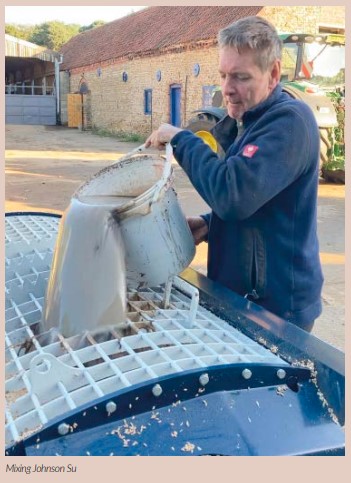
The results from the Horizon drill have been pleasing. We have succeeded in uniformly sowing, four millimetres deep for quinoa and grass seed and twenty to thirty millimetres deep for wheat and meadowfoam. Although a small company, I feel that if you are looking for a no-till disc drill, I would recommend the Horizon along with demonstrations of the more established drill manufacturers. As we look to the future and the threat of losing glyphosate, my thoughts are that maybe the drill manufacturer should sell inter-row guided weeders which are compatible with the drill sizes and coulter widths. This may be blue sky thinking but the Chameleon drill has already gone through this thought process.
After exploring the options of mixing a Johnson Su compost extract with “out of the grain store “wheat seed, I stumbled across an Agritrend concrete mixer bucket. I mentioned in my previous article about the Haggerty’s in Australia were using a grain auger to blend the liquid extract with the seed, however for some reason or other I thought that I would go with the concrete mixer bucket and if all else failed at least I would be able to mix reasonable volume of concrete. The cost of the bucket was more than most would want to pay, but I am pleased to report that Anna and I successfully mixed or blended ten litres of liquid with half a tonne of seed, we then opened the chute at the bottom of the bucket and let the bucket sweep the seed into the drill. This was a batch operation, and four batches filled the drill. The seed flowed well through the metering devices and has emerged evenly, will it make a yield difference? Watch this space.
David White kindly alerted me to Michael Horsch’s Christmas Fireside chat on YouTube. It was an enjoyable video and at one point Michael discussed making compost in Bavaria using a blend of green chopped cover crop together with chopped straw, the idea being that the straw might turn to some sort of biochar within the compost. The compost would be anaerobic and therefore did not require turning, this appealed to the lazy part of my nature. My brain engaged gear, I did not have access to chopped cover crop, but I did have an aftermath of grass after the grass seed had been harvested (with a stripper header), as well as access to straw. The other benefit would be keeping the straw and grass in the loop of the farm, also avoiding buying in any contaminated compost.
I eventually contacted Michael Horsch to learn a little more about the process, to my astonishment, I got an email from the man himself. I was almost as exciting as receiving an email from the Queen. Michael explained that the constituents were roughly 50:50 and pointed me towards work that had been carried out by Walter Witte from East Germany.
Much of the Walter Witte work was in German but I gleaned that volcanic rock dust was also added, the sides Mixing Johnson Su of the clamp should be consolidated, and the height of the clamp should be around 2.5 metres high. After Christmas I watched more YouTube, this time on Bokashi which is an additive to assist anaerobic composting, Bokashi can be mixed by yourself, but I decided to buy some from Agriton. This wacky plan was coming together. The Michael Horsch YouTube showed the forage being chopped and collected with a Pottinger forage wagon. I was reluctant to go down that route and eventually found a contractor who used a whole crop forage harvester to collect the compost constituents and apply the Bokashi liquid. Andrew Sincock from Agriton suggested adding seashells and I also purchased some rock dust from Remin.
On the day of the compost making, there was much more grass than I had estimated, so the quantites of straw, rock dust, seashell and Bokashi mix could have been increased. The product was placed on a concrete pad and Carl mixed the whole lot with our loading shovel. We are now the proud owners of about 700 tonnes of compost which may or may not be of any benefit, again watch this space.
My daughter Anna who changed her career at the beginning of lockdown to become a farmer, has gone through a huge learning curve. A lot of what I learnt at Agricultural college is not particularly relevant to this new system of Regenerative farming, so Anna is learning everything alongside me. Anna has a new border collie pup dog called Luna who has got through the biting stage and may be introduced to sheep training soon. One hurdle might be that neither Anna or myself can whistle and Anna has tried the half moon whistles that go inside your mouth but that too, is not going well. Luckily Anna has found a group of ladies on Facebook called “Ladies who lamb”. She has so far quizzed them on various aspects of husbandry as well as what is the best footwear, I suggested that she quizzes them about whistles. She mentions that the ladies’ group of sheep farmers is incredibly positive and encouraging, whilst the men’s group needs to work on the supportive element.
Anna has been a photographer and is familiar with social media. This got us into another scrape after I responded to a Base UK committee request from Satchel Classes. They wanted someone to promote Agriculture as a career opportunity, I volunteered Anna and myself and last week we jointly made a YouTube video to promote the cause. There were a lot of mistakes, but the Satchel people liked it, I hope that our mistakes might bring in a comedy element to hold the children’s attention.
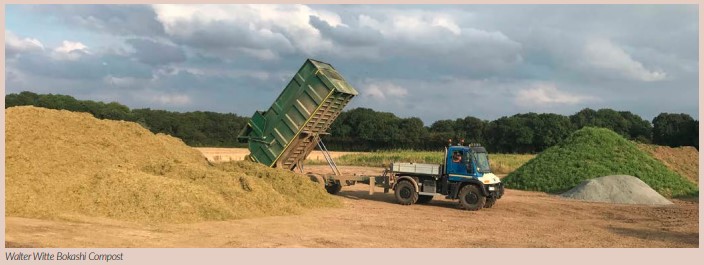
Anna has also been approached by a film crew wanting to make a UK equivalent of “Kiss the Ground”, their version will be called “Six inches of Soil”, I will probably be asked to consult on the movie.
“There’s really only one place where we can put all the carbon dioxide and that’s in the land” quote from US farmer Ray Mc Cormick, Indiana. This sentence resonated with me and echoed what many books have been trying to put over. It’s just a great shame that people in government don’t read the same books as me. BASE UK exists to share and transfer knowledge relating to conservation agriculture and the modern name of regenerative agriculture and it is these agricultural practices that could as Ray states above, help save the planet.
Throughout the summer Base UK members are encouraged to host farm walks and invite other Base members. Probably nationally there are hundreds if not thousands of farmers who look over hedges at no-till practices and half hope that the no-till farmers with their much reduced workloads, might go bankrupt in five years, thus, proving their conventional system to be right and regen farmers to be wrong. It occurred to me that I should also invite non-Base members to my farm walks, to explain what I am trying to achieve. Hopefully other Base members in my region could also host farm walks where we could all invite a non regen farmer, thus creating some debate over a beer and a bar snack in the pub afterwards.
Within the last year and a half, the Base UK membership has grown from around 200 to 483, this is a good news story, and I would strongly recommend that you sign up for the Base UK Conference in February 2022. The capacity of the Crowne Plaza Hotel in Nottingham will be 300 and bearing in mind the size of the membership, to benefit from the great line up of speakers and the social networking with like-minded people, it would be wise to secure a place in good time.
For recent regen updates follow Anna’s Tik Tok
account. @farmerAnnaJackson. -

Are You Happy With The Quality Of The Lime You Purchase?
Written by James Warne from Soil First Farming
A word of warning to all of you who buy bulk lime products. There appears to be nobody in the supply chain fighting your corner to ensure the quality of the lime you buy meets the legal requirements as laid down in the Fertiliser Regulations 1991. 100% of the bulk lime products we see tipped on farm does not meet these specifications in terms of particle size. Even if it’s being sold as screened lime it fails to make the specification. This low quality lime will not be able to neutralise soil acidity as quickly, or for as long, resulting in declining crop performance. I encourage everyone buying bulk lime products to take a sample from the delivered pile before spreading and get it tested for Neutralising Value (NV) and particle size distribution to make sure it meets to specifications of the product. The correct specification is given in the table below. If the analysis results show substandard product, talk to your supplier and send the results to the Aglime Association. It’s only by collective effort that we can encourage change. Always request ground agricultural lime from your supplier and put it in writing.
The Aglime Association, which represents lime producers, has launched its own assurance standard to ensure product consistency from the quarries. But why do we need another assurance standard when the supply requirements are laid down in law? I mention this topic regularly for good reason. Farmers are paying for sub-standard inputs which can be very costly, not only in the purchase and spreading price, but also the knockon effects of reduced output. Low soil pH can negatively affect nitrogen use efficiency. With urea trading at ~£700/per tonne you need to ensure that you are maximizing its efficiency.
All ag-lime sold in the UK must meet the requirements of the Fertiliser Regulations 1991 to be sold as lime, for the purposes of this article I will look at limestone only, but these regulations also apply to dolomitic limestone, chalk and many other types of lime. The table below is taken from the Fertiliser Regulations.
Grind size
Don’t just buy on neutralising value, the particle size distribution is critical, almost more so. To put it in context, Lincoln Cathedral has a neutralising value, it’s built of limestone after all, but it won’t neutralise very mush due to the low surface area to volume ratio. Grind the stone to 150 micron and it will neutralise acid, provide plant available calcium and react well. Once the levels start to decline the effectiveness of inputs also starts to decline and the return on investment declines alongside. The health of the crop suffers which results in an increase in inputs which are already under pressure. You can see this becomes an ever-decreasing circle of increased cost and decreasing output.
As mentioned above we now know that grind size is as important as neutralising value in determining whether the lime will actually do as intended. This is where the fertiliser Regulations 1991 become relevant because they set out the standards for lime quality as a fertiliser. If we consider these regulations for a moment it is clear that both the neutralising value and the specific material name must be given, in addition the percentage by weight passing through a 150 micron sieve must also be declared (the grind size). A limit of variation (tolerence) of 5% is allowed.

By grinding the rock finer we are increasing the surface area of the product. It is this increase in surface area which allows the lime to react faster and bring about quick reductions in soil acidity. If we calculate the degree of grinding and surface area we can see from the table above that ground limestone has a surface area nearly twice that of screened limestone, while prilled lime products can be four times the surface area of screened limstone. This increase will give greater reaction and therefore faster pH reduction.
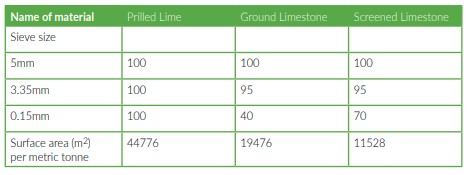
So how fine does the rock need to be ground to be effective? The aglime website states that “coarser material requires a heavier application” and “There is a considerable reduction in the effectiveness of liming materials containing particles above 600 microns (0.60mm, 60 mesh) unless the material is easily broken down”. The finer the lime is ground, the more effective it becomes. This is supported by work taken from North Carolina University in the US shown to the right;
This graph clearly demonstrates that lime in the range of 0.177 – 0.150mm (177-150 micron or 80-100 mesh) gave the quickest pH rise and most sustained pH rise. The larger particle size 0.841mm and above gave a very limited pH increase and took 18 months to achieve it. Focus on the detail of the basics and the output and profitability will follow. My advice to you is avoid buying bulk lime altogether because you cannot guarantee what you are going to receive and instead buy a guaranteed quality product such as a prilled lime which will work for you every time.

-

Drill Manufacturers In Focus…


With an increasing number of growers now reaping the benefits of lower disturbance drilling such as the Mzuri
system, we take a closer look at other implements which can prove invaluable to those on the direct drilling journey.Stubble Rake
As we say on our own farm, ‘It starts with the combine’. The first step in direct drilling a typical field is combining the previous crop, so it is only right that this step sets up the field for effective drilling and makes best use of any remaining crop residue. That’s why we like to use the Rezult stubble rake to even out any combine mishaps and ensure an even coverage of straw across the field. Fitted with leading discs, these make an invaluable addition to any rake for chopping surface straw and mixing it with surface tilth to accelerate decomposition. This tilth also makes it easy to create stale seedbeds and encourages a flush of weeds and volunteers ahead of drilling.
A couple of passes of the Rezult, a few weeks apart can make best use of chemistry for an effective weed kill. By opting for a stubble rake with leading discs, it also gives operators the added flexibility to use as a means of establishing low-cost cover crops when fitted with a seeder box.
The Rezult rake is also an ideal tool for cutting slug activity, particularly in OSR stubbles, where disrupting slug habitats and exposing eggs to the midday heat has huge advantages for reducing slug populations in the following crop. For Rezult’s fitted with a seeder box, slug bait can be applied at the same time to pack an even bigger punch.
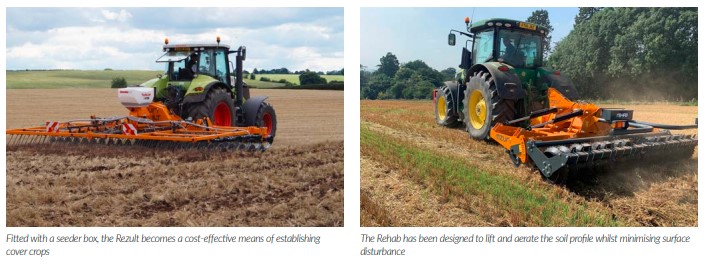
Low Disturbance Subsoiler
Whether it forms part of the transition to direct drilling, or used periodically for fields requiring remedial care, a low disturbance subsoiler is a great addition to the direct driller’s arsenal. Our Rehab low disturbance subsoiler has been redesigned for 2021 featuring leading discs, shearbolt protected legs and heavy-duty V-shaped roller packer. As direct drillers turn to less disturbance, some growers report experiencing compaction issues at depths of 6”-8” as a result of machinery passes or long periods of heavy rainfall. The Rehab has been designed to alleviate this type of compaction whilst staying true to growers’ requirements for low disturbance.
The Rehab features spring loaded pivoting discs which act to slice through topsoil and crop residue, allowing the following leg to lift and aerate the soil profile whilst minimising disturbance to the field surface. A generous leg spacing of 500mm and a stagger of 750mm promotes an excellent flow of crop residue through the implement to reduce the risk of blocking up in high-residue environments – something which is important to maintain for many direct drillers. Operators can determine the level of fracture through the soil profile by choosing from three wing widths including 55mm, 115mm and 135mm. The legs are protected by ‘hammer-thru’ shearbolts rather than hydraulically pressurised to maintain maximum draft control and the correct draft angle of the wing for more efficient use and lower disturbance.
When designing the Rehab, it was important to create an implement that would leave the field with a weatherproof finish, perfect for direct drilling. The Rehab achieves this by incorporating a V-shaped packer roller which is designed to consolidate either side of the leg and leave an even finish. By minimising surface disturbance and working with previous crop residue, the Rehab achieves better moisture retention whilst ensuring sufficient lifting of the soil profile, complimenting direct crop establishment.
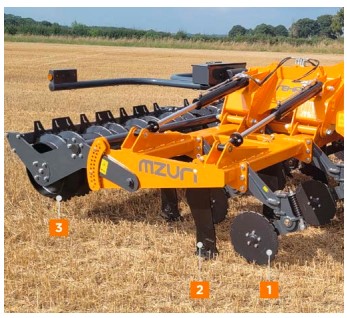

-

Farmer Focus – Tom Sewell
The good the bad and the ugly!

As I sit here on the 30th November furiously tapping away to get this written for tomorrow’s deadline I reflect on what has happened since I last wrote. My last piece mentioned how well the crops looked before harvest! How things have changed in just those few short months. The price of wheat, fertiliser and machinery (if you can get it!) have shot up which is encouraging for those who still have wheat to sell and who bought their fertiliser early! I also mentioned the upcoming Groundswell Show which has now been and gone. For me it was a fantastic day (I only went on day 2) bumping into old friends from college, Nuffield, Worshipful Company courses and from interactions on Twitter! I was surprised and dead chuffed to be awarded the Soil Farmer of the Year at Groundswell which has landed me a couple of speaking engagements over the coming months.
I’ve titled this article “Good, Bad & Ugly” as for me that’s what has summed up the past few months. Looking through magazine articles recently they all seem to feature farmers, growers and advisors who get it right every time and never make any mistakes. They all grow 16t/ha of full spec milling wheat and sell it at the top of the market having bought all their inputs at the lowest price. Their farms are all ring fenced with big open fields and theres never any misses in their drilling! Unfortunately, that’s not the reality in my experience and i wanted to just show some of the ways in which we have learned from our mistakes. So, here’s goes
The Good
For me this year I’ve been thankful for a healthy family particularly during the ongoing pandemic. Our 4 children are now at 4 different schools which makes our travel logistics challenging. We have also been blessed this year with fantastic harvest labour on the farm. A call for help on twitter resulted in just the right person coming forward who was keen to learn and competent to get the job done. He had farming experience, was well mannered and was quick to learn (he also played hours of FIFA with my boys!!). Having never drilled a field before we set about throwing him in the deep end and he drilled almost all of our cover and catch crops this year as well as barley wheat and beans. I’m sure he will read this so thanks Jonny, top job! We also had help from Ellie, a student who was keen to learn and did an outstanding job carting grain through our narrow and winding lanes and helped with muck & compost spreading too. Nick was our final part time helper who jumped on a tractor when we were hauling back from the farthest fields and with cheerful confidence managed to get the job done.
Another “good” was the ongoing relationship that our “Nutters” group continues to develop. Having likeminded farmers locally that we can bounce ideas off, meet up with and critique each other’s ideas is incredibly valuable. I’m thankful for everyone of them and having local groups of farmers all looking to improve soils and reduce inputs is something I would encourage you all to try to set-up or become part of.
After many years of friendship and reliable service our independent agronomist, James Rimmer, decided that Norfolk was a nicer place to live and at the end of harvest we said a sad good bye to him walking our fields. It gave me the opportunity to evaluate where we were going and rather than just accept James replacement, we looked at alternative options and employed the services of Edaphos & Mike Harrington for all our agronomy, soils and nutrition advice. Just last week we hosted a brewing day on the farm where Mike, George Hepburn and Nick Woodyatt from Edaphos spoke about biological brews and some of the pitfalls with No-till/regen-ag.
We have also taken the opportunity to try a Horsch Avatar single disc drill and a Horizon drill this autumn. Both drilled winter beans into wheat stubbles and we were impressed with the job that both drills did. With our expanding acreage and the addition of more contract drilling this year we are finding that our cross-slot drill is struggling to get round the fields in the short drilling window that suits it. We are now collecting compost from a neighbouring soft fruit farm which we will apply next harvest. We applied compost to a lot of our newly acquired land this year and along with chopping the straw, growing cover crops and a more diverse rotation we are hoping too improve the soil and its ability to hold water particularly in the late spring and early summer when our soils can often dry out.
So what was bad?
I got COVID! And so did my wife AT THE SAME TIME!!!! It’s now 4 weeks after we both tested positive and i still can’t smell anything and taste is not back to normal. Harvest weather!! After what looked like it would be a bumper harvest in May, the summer really failed to deliver any real meaningful sun or heat. June, July and August can be described as dull and overcast in the main and the deluge of rains we had during haymaking kept soils soft and moist throughout most of the harvest period. We cut hardly any of our crops dry although quality did remain largely good. Fortunately, we are members of Weald Granary which is a farmer owned co-operative grain store locally. They were able to take additional tonnage due to the lower harvest yields locally and have been an absolute God-send in taking all the damp grain that we harvested.
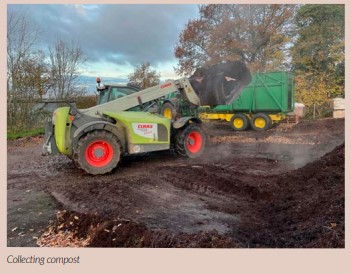
With the damp and late harvest, we found that chopped straw didn’t break down in the same way as in previous years. This has resulted in high slug populations this autumn and tricky drilling conditions. Cover crops have also really struggled to get away. Admittedly they were planted in the second half of august and had 65mm of rain soon after, but they have been hammered by slugs and the stripes in the stubble created by the drill remain to this day! I still maintain the view that cover crops need to be drilled early and need sunshine!
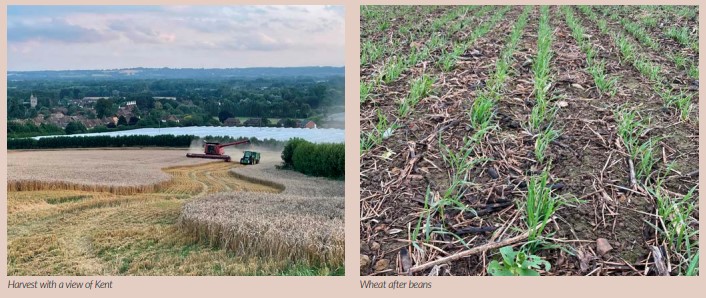
So surely nothings ugly?!!
Well, drilling beans with a no-till drill in late November into sticky clay is not the most enjoyable job and I look forward to unblocking the press wheels on the back of the cross slot as much as a Red Tractor audit!! The beans are drilled, all 20 fields of them, but I’m not sure we’ve made the prettiest job. A bigger drill would have allowed us to plant them all in October when ground conditions were that much dryer. We certainly learn from our mistakes!
The coming weeks and months will see us busy with logs, workshop maintenance, some meetings and the annual BASE conference which I’m attending this year. We are also looking to simplify a number of our grain stores with old bins and drying tunnels being removed to aid harvest logistics going forward.

Can I finish by wishing you a very Merry Christmas and a Prosperous New Year.
-

Soil Farmer Of The Year

The Soil Farmer of the Year competition has been running since 2015, providing a platform for individuals and
businesses to demonstrate how soil management can build environmental and economic resilience. The competition aims to recognise, promote and champion farmers who are passionate about safeguarding their soils and demonstrates how despite the vast variation across the agricultural sector, sustainable management can be universal.This year’s competition was conducted in association with and kindly sponsored by Hutchinsons and Cotswold Seeds, with ongoing support from Innovation for Agriculture. Traditionally the results of the competition have been announced on the main stage at Groundswell agricultural show, and 2021 saw a return to this practice following the cancellations associated with COVID-19 in 2020. The winning farmers from this year’s competition, Tom Sewell (Arable), Sam Vincent (Livestock) alongside Antony Pearce (Runner-Up) joined their fellow finalists ( Jack Martin, Mark Oldroyd and Rob Raven) in discussions of their soil health and regenerative management strategies through presentations to the Groundswell audience.
Following the announcement of the winners at Groundswell, the winning arable, livestock and runner-up farmers are invited to hold farm walks which are open to the wider farming community. These walks provide a platform for discussion and practical demonstration of how different businesses and approaches have focused upon soil health and land management.
Arable Soil Farmer of the Year, Tom Sewell from Kent led a tour around his farm during late July to discuss how his management approach has benefited business efficiency and soil health. As a previous Nuffield Scholar Tom has a passion for regenerative farming and sustainable farming practices centralised around no-till systems. A founding member of BASE UK, Tom himself has often contributed to Direct Driller magazine. The farm constitutes around 1500 acres split between 15 different landowners across 8 parishes, all of which is combined into a variable portfolio of soils from river silt to heavier and rockier ground.
Explaining his management approach as “We’ll get it right, but it takes time, effort and attention to detail”. Challenged with managing highly variable soils Tom has adopted a biologically focused approach, explaining “We maintain the good structure by not ploughing and instead using our worms”. An early adopter of a Cross Slot drill, Tom aims to simplify his arable system through minimising tillage where possible to keep costs low, adding “look at what you do and why you do it and see if you can cut it out”. Inspired by his Nuffield scholarship, Tom has transitioned towards no-till over a number of years, progressing from a disc press to a Simba Free Flow drill before settling on the Cross Slot.
To maximise the benefits soil biology can provide, cover crops and compost are used to encourage ecological processes to build soil structure and infiltration alongside carbon sequestration. Chopping straw is another practice that Tom has implemented, providing available residues for biological breakdown and soil organic matter building, he states “I just want to improve the soil, I use compost and feed the worms, they’ll do the rest”. Acknowledging that it takes time to build a resilient and dynamic biological system, new land taken into management is treated in this manner with the hope of adding “life back into it” following previous intensive arable or orchard management in other systems. Tom’s compost is usually produced from horticultural by-products such as spent strawberry and raspberry plants and is seen as vital to his system through encouraging plant rooting and worm activity; a key metric Tom uses across his farming landscape.
Through conducting worm counts and testing he approximates there to be 12 million worms a hectare on average.
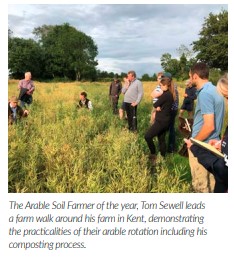
Logistical challenges alongside those of soil type and weather guide Tom’s decisions on farm in matters such as cover crop selection. Understanding what a cover crop is being used for helps guide budgets and rotational choice, consequently resulting in there often being fields which are left without cover if it doesn’t suit the conditions. However, cover crops still constitute a key management practice implemented on-farm due to the benefits as Tom explains “The cover crop helps to provide that living root and to get organic matter and carbon back into the soil and help the soil to perform”. Increasing organic amendments and encouraging soil biology has enabled Tom to reduce nitrogen applications by 10% for each of the last three years. Balancing applications with a source of carbon helps Tom to continue supplying a above and below ground nutrient supply with fewer kilos of nitrogen.

This year’s Livestock Soil Farmer of the Year, Sam Vincent manages his 100 cow dairy farm using 130 hectares of permanent pasture without the need for re-seeding in the past 15 years. Based in Dorset, Sam transitioned his herd to organic in 2018 following the challenge of a TB breakdown, explaining “once our cow numbers were lower and following a couple of years where we had cut our nitrogen back dramatically and seen an increase in grass yields we felt ready to make the jump”. Averaging 5,500 litres per cow, Sam looks to maximise his grazing system to minimise costs. Cutting nitrogen usage from 120kg per hectare to only 35kg and seeing success gave Sam the confidence to make the change to an organic milk contract with Arla as well as becoming a member of the Pasture Fed Livestock Association for cattle sold for beef.
Soils on the farm are variable, and range from higher clay content to more silt based loams. Sam minimises trafficking across his grazing area, avoiding topping and rolling where possible and allowing the cattle to do the work instead – “If you’ve got a rotation, with cattle who are utilising the pasture, then you don’t need to be sat on the tractor”. Sam has seen vast changes not only in his pastures and cattle performance, but equally with his farming approach, explaining “Before we went rushing around, we’ve now got time to stop and think – feel better. We are more resilient and sustainable now”.
The herd calves in late summer in a single block, which in the future Sam hopes to bring earlier on into the season to a May/June timing. Grazing management is critical to Sam’s success with cattle out early March until the end of November. Youngstock are often grazed for longer on fields away from the dairy to optimise nutrient cycling around the grassland area. Any cattle destined for beef are outwintered using a deferred grazing system, shutting off the driest fields on the farm in early summer and lining out bales. He explains. “In the past we were going back and back to the same fields, eating everything and leaving nothing. Now we try to lengthen our rotations as opposed to keeping the grass continually short.” Sam’s approach can be considered as ‘mob grazing’ and he has seen success with this management system with his British Friesian herd, combining his grazing strategy with a small quantity of concentrate feed (6- 800kg) – “We needed a cow that has longevity, and will work on our system”
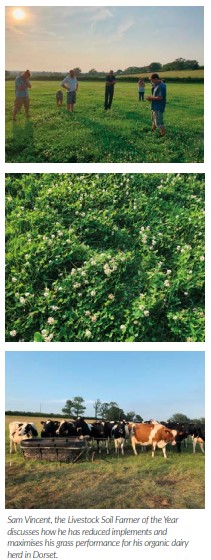
Sam manages forage quantity and quality through monitoring his grasslands, with previous management practices such as predominantly ryegrass re-seeds altering the clover stand in some fields. He explains “We should have done things a little bit differently, but that’s how you learn”. The milking herd are moved twice daily at 12 hour intervals with back fencing – “We cut fields and graze fields in a rotation rather than continually cutting all the time, the flexibility needs to be there to decide based on grass condition and stocking. The fields at the other end of the farm benefit a lot from the flexibility, the soils are a lot shallower”. Using this system Sam has implemented troughs which are designed to be mobile through the use of a skid, meaning that they can be moved daily with the cattle.
Through monitoring grazing behaviour and milk quality Sam is able to tailor his future management plans on a field by field basis; looking at plant growth stages rather than having a predetermined plan, Sam aims for a 40 day plus field rotation which has previously been highly successful – “increasing the rotation length to 50-60 days, and leaving higher covers we are seeing diversity within the pastures which is as a result of management”. To measure grassland performance Sam currently uses a plate meter and samples the cover and stand regularly, however future developments with satellite measurement is something that he sees being useful.
Transitioning to this management system and reducing fertiliser application rates has seen Sam’s pastures increase in species diversity – “some people think, in order to get diverse leys you need to rip it all up and start again, but that isn’t the case”. Understanding that throughout the grazing season the species available, such as early season foxtail and later vetches and trefoils, will vary helps manage the ground. Sam explains “We have fields that haven’t been reseeded but have still got diversity including trefoil and native red clover.
If you reseed with ryegrass, the species that come back once the ryegrass dies back is weeds, usually annual meadowgrass and other non-productive species”. The flexibility of the grazing system, through cutting silage at a similar height to that at which the cattle would naturally produce maintains this adaptability – “if you have a field that you were going to cut but the weather turns wet then it isn’t the end of the world, you can simply go back and graze it”. The highest risk period like on many farms is often early spring -ground is soft and consequently Sam finds that higher residuals and lower stocking rates help to protect the structural integrity of the soil from poaching.
Regularly weighing cattle helps manage youngstock as they develop. Reared without concentrate on a whole milk diet, Sam finds that separating them into smaller groups when they are turned out they can be easily fed with a 50 teat feeder whilst they begin to graze. Youngstock are managed with a back latch system, being moved once per day onto fresh grass – “if we let the stock graze it then we don’t have to haul the muck out there” adding, “FYM is spread in April on ground which that had been grazed and spread on ground which is cut for silage later after cutting.” Through covering all manure stores, Sam has minimised the need for irrigation of dirty water and installing over 4000 railway sleepers for tracks has increased accessibility across the farmed area. In addition to the cows on farm, Sam also utilises pigs to help compost his FYM in cattle sheds. Through adding corn to the sheds the pigs mix the remaining material over a 6-8 week period.
Having initially experienced a lower yield through minimising concentrate use on farm, Sam has seen the benefits of a lower input system – “Milk from forage percentage is high and milk solids have gone up. Not having inputs makes an impact on the beef/dairy. Organic milk price means that the impact has been minimal. The business is a lot more stable.”
Buckinghamshire farmer Antony Pearce is this year’s Soil Farmer of the Year Runner-Up. Having been inspired to start his journey into regenerative agriculture after reading David Montomery’s book, Antony began to transition away from his existing “safe and conventional system”. The 300 hectares of heavy clay arable ground is run in a split system. Half of the farm is under full “regenerative” management and the remaining 150 hectares in what would be considered a more conventional system, allowing Antony to financially monitor the performance of each approach. He explains “My original reason for looking at a low input system was after some conversations that yields were showing what organic farmers would expect. My 10 year average from the conventional system is 9.1 tonnes per hectare. Comparing the numbers, I was spending £130 per tonne for every additional tonne over organic yields. This seemed like something to focus my attention on”. The true success of any regenerative farming practices trialled on the farm is when a particular approach is also incorporated into the “conventional” proportion of the farm. Through his YouTube channel Antony shares and discusses his journey, highlighting the successes and challenges that he has found throughout his journey.
Focussing on soil health, Antony has gone on to attend Elaine Ingham’s soil health course to realise the importance of the rooting matrix of a plant and the environmental conditions required to access nutrients made available by microbial activity. He explains “Plants are able to secrete 30-40% of their energy through their roots to feed the bacteria and fungi in the soil” adding, “If we are relying on the soil fungi to feed the plants, what negative impact are the fungicides having to this relationship?”. Subsequently, Antony has begun to remove fungicides from his crop protection program, eliminating their use entirely from 150 hectares which is managed in a wholly regenerative manner.
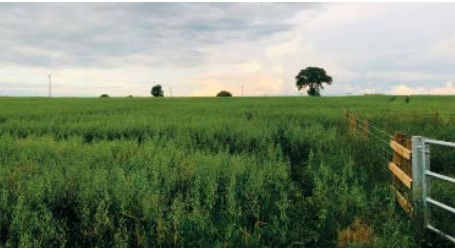
Runner-Up Soil Farmer of the Year, Antony Pearce demonstrates how he has reduced inputs and utilised data to analyse the success of regenerative practices at his farm in Buckinghamshire.

Instead focus is upon genetics and variety to provide a natural resistance to disease pressure. Awareness that the carbon from root exudates is often utilised by microbes following nitrogen application, Antony has also moved to reduce artificial fertiliser application. Having initially relied upon imported organic manures for nutrition, Antony now implements cover cropping as a more cost effective approach, finding benefits of a clover or rape/fenugreek understorey blown into a standing wheat crop for blackgrass suppression – “whether it helps my rape yield is immaterial, I don’t want a carpet of blackgrass!”.
Antony is currently producing oilseed rape using 30kg of nitrogen from digestate and a further 15kg from foliar applications, without any fungicide or insecticide usage. Furthermore, in the previous season Antony had produced a 6.5 tonne a hectare wheat crop on a zero nitrogen system and Elianne oats on a gluten free contract for human consumption using only 15kg of foliar nitrogen and stubble raking to liberate what was already existing in the soil. When conducting nitrogen trials with different products, Antony always leaves a control strip for comparison of the financial and crop data – “there is a need to provide the evidence as to what works on your farm”.
All straw is chopped to help contribute to organic matter and overall soil health, and again using a stubble rake after drilling oilseed rape to help with slug suppression. This can create a rotational challenge for Antony as it hinders his capacity for cover cropping – “It’s a balancing act, if you go for slug control, you need to rake, rake, rake but you then forego your ability to have a cover crop. Sometimes we manage to get cover through the rape volunteers and it fulfils this function at the same time”.
As a farm based on heavy clay soils, there are often challenges with trafficability – but focussing on soil health has started to produce results. Regular applications of compost made from a 50/50 mix of cattle muck and woodchip are a major component of Antony’s management practice. Through applying compost in the 5 years prior to a wheat crop, Antony hypotheses that 200kg of nitrogen should be available for uptake. Improving soil health through composting and cover cropping has also seen benefits in water infiltration and holding capacity, something Antony was keen to maximise following a visit to Gabe Brown in America and seeing the benefits this had.
He explains “back in the winter we had a big crop of mustard, and there was a big rainfall event (around 100ml), the field walked beautifully – it managed to hold onto the water and soak into the soil”. Furthermore, the nature of heavy clay and its predisposition for extreme behaviours such as waterlogging and drought are a constant challenge, but through Antony’s management the rotation has become more flexible – “we can now start to develop a system where we can effectively capture water over the winter through the use of a cover crop which lets the rain work its way into the soil, then I don’t need to worry about spring droughts as the water reserves are there”.
Antony has also begun to integrate livestock into his arable program, grazing sheep on his cover crops before drilling to introduce more organic matter and nutrients back into the soil profile. He explains “Without a doubt we need to leave at least a month between the sheep coming out and us drilling. The soil needs time to recover, the worms need to come up and grab the muck and reintroduce the air into the soil”. Further adding, “We want the sheep to hit is quite hard and move on, which sometimes can take some explaining. We try and design it so the sheep are hitting the mustard stands earlier in the season and then move onto the vetches later”. Alongside the sheep, Antony has also diversified into other opportunities such as sloe gin, turkeys and dog arenas -maintaining future financial as well as soil focused resilience.
The three farm walks demonstrate the vast knowledge, adaptability and versatility of approach to soil management. Our three winners continue to demonstrate their passion for soils and the benefits that maximising the quality and resilience of this biome can provide for their businesses.
The Soil Farmer of the Year competition for 2022 will launch on the 5th of December (World Soils Day). If you are interested in applying or would like to nominate someone who’s work in soil health and farm resilience deserves recognition more information can be found at www.farmcarbontoolkit.org.uk.
-
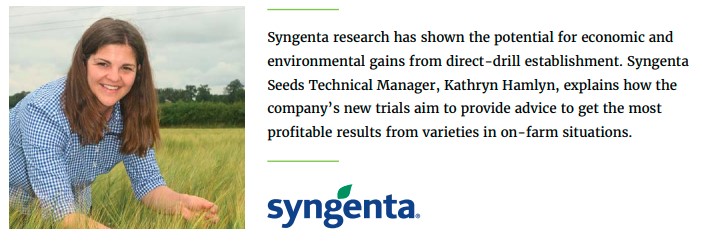
Trials To Bridge Direct-Drill Yield Gap

A new approach to crop trials will provide an essential insight into how seed varieties perform under different establishment systems, enabling better advice aimed at maximising performance in the field, including specifically for direct-drill systems.
While the Recommended List (RL) trials have historically been designed to accurately reflect the genetic potential of a variety, and do give growers crucial comparative data, they are typically undertaken with specialist small-plot equipment, under intensive conventional tillage, in ideal conditions and managed to the nth degree to exploit the best from the seeds.
Now, at Syngenta we have instigated an exciting new trials programme to run in parallel, aimed at bridging the gap between the small plot trials and different farm practices – to bring a better understanding of how products and varieties perform. The trials will better reflect real farm scenarios, to aid more appropriate agronomic choices, as well as integrating other pressures and influences that impact on growers’ decision-making process.
Key to the move has been investment in a pioneering new trials drill and equipment, purpose designed to enable establishment in a range of systems, from conventional tillage right through to direct drilling into stubble or cover crops. It also facilitates trials to investigate how wider agronomy aspects, such as drilling date, seed rate, drill coulter width and cultivation methods, influence how varieties will perform.
The bespoke new drill has been made to Syngenta specifications by Huffle Engineering. The coulters on the drill can be swapped between tines and discs, depending on the drilling scenario required. The row spacings at 12.5 cm allows trials at 12.5, 25, 37.5 and 50 cm crop row widths – to compare results and enable alternative practices, such as mechanical hoeing. The dual hopper on the drill also facilitates trials looking at fertiliser applications at drilling, for example, or companion crops, such as wheat and beans at different seed ratios.
Seed trialist, Rory Hannam, explained that this unique drill has been specially designed to be more flexible than other conventional trials drills. “It’s a step forward for Syngenta and opens up a whole range of possibilities with the trials work that can now be done,” he added.
The seed trials’ development builds on our five-year Conservation Agriculture and Sustainable Farming Initiative, comparing crop performance, financial results and environmental implications of crop establishment using three different systems – conventional plough-based; non-plough tillage and a direct-drill.
Independently monitored and evaluated research, involving over 10,000 measured data points, covers a full-farm rotation on a heavy land site in Leicestershire and a light land farm, at Lenham in Kent. It has shown that while establishment can be more challenging under a direct-drill system and yields might be reduced, particularly in the early years of transition from conventional systems, overall the net farm profitability can be up to 36% higher on light soils (19% on heavy land), and the environmental gains hugely enhanced.
The research has proven the potential for direct-drill conservation agriculture techniques to significantly cut greenhouse gas emissions, by around 16%, and reduce the carbon footprint of crop establishment on both heavy and light land farms by nearly 10%. Earthworm numbers on the light land soil have been boosted by up to 75% under the direct-drill regime.
However, we found that over the course of the trial across the two farms, establishment has been lower with the direct-drill or light-till establishment, down by around 3% on lights land and 9% on heavy land. Overall average yields have been down by an average of 7% on the heavy land, but up 3% on light land soils.
With the potential economic and environmental gains seen from direct drill establishment, the emphasis of the new Syngenta seeds variety trials’ is now looking to overcome that yield gap with appropriate agronomy responses, to get the best performance from varieties.
In the first season’s trials, for example, results confirmed the challenges of spring barley establishment under a direct-drill system on the company’s heavy clay-loam trial site in Cambridgeshire, into soils that had previously been conventionally ploughed and tilled. Across three different seed rates, of 350, 420 and 525 seeds per m2, establishment was 30% lower with the direct-drill system, compared to minimal tillage or plough-based conventional tillage.
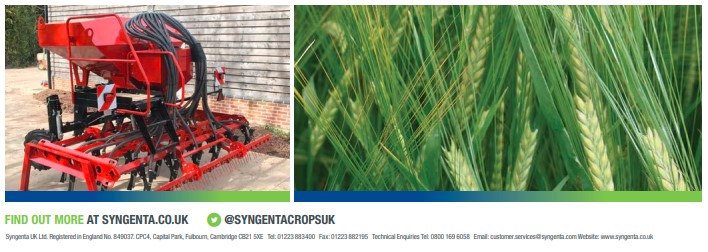
Furthermore, tillering was greater in the plough-based system, compared to both min-till and direct drill. Compounded by weather conditions after drilling with the lowest April temperatures and rainfall for 30 years, followed by low temperatures and wet conditions in May, this was reflected in the yields where the plough-based establishment was highest. This also showed the increase in seed rate did give a large rise in yield with the direct-drill establishment.
Increasing spring barley seed rates did also have an effect on increasing yield in each system, however this was minimal in both the plough and min-till systems and did not cover the extra seed cost. The variety selected for the trial was the dual-purpose spring malting barley, SY TUNGSTEN, with potential for both the brewing and malt distilling markets. It has Provisional MBC approval and is undergoing its final year of testing in 2022, with the important attraction of performing well for growers across England and Scotland.
We plan to repeat the trial in 2022, along with similar trials for winter wheat and winter barley, with an increasing range of varieties. A long-term research project will also look to see how multiple years of the same establishment system, including direct drilling, impacts on variety performance.
The information we have gathered from these trials will prove essential in helping growers select the most appropriate varieties and agronomic inputs to get the best results from their specific on-farm establishment systems and individual situations. Building a greater knowledge bank of varietal responses to cultivations, in-season agronomy and weather conditions will be essential for farmers’ more effective decision making in the future.
-

Become A Direct Driller Patron, Pay It Forward
Written by Clive Bailye
Knowledge is power and it’s exchange is valuable. When I first considered changing the way we farmed I quicky began to realise and understand I didn’t really know how to, I needed to learn, fast.#
I sought out others that had the experience and skill set I knew I needed to have any chance of success. I was extremely fortunate that without exception everyone I spoke to was happy to help me and share knowledge often passed to them previously by others. These farmers all know who they are, some were in the UK so easy to reach, others I learnt from often required significant travel and the cost associated with that. I invested time and in some cases money in my reeducation and thankfully others invested their time in me, without reward and for that I will be forever grateful. It was an investment that has since paid me back many times over.
Direct Driller magazine was conceived just 4 years ago out of frustration that other farming media lacked the independence and quality information a farmer would need to move successfully to a regenerative agriculture system. Although the team behind bringing you the magazine have a web-based background, we realised that printed information can be powerful and physical media can be kept as a valuable source of reference on a shelf. As interest in alternative farming systems grew, we saw there was a rapidly growing movement in UK agriculture that really wasn’t being served, encouraged by others we felt we needed to fill that gap.
Following our core principles, we were determined to remain as independent as possible. Advertising was to be kept to a minimum and focus placed as much as possible on farmer’s content. We knew that farmers learnt best from other farmers and by blending it with quality information from academics and researchers in the same pages, we could create a truly interesting and useful publication that subscribers wanted to read from cover to cover. We have so far remained true to that ambition, this magazine carries only just enough adverts to cover its cost, none of the editorial staff or excellent farmer contributors are paid, we rely heavily on the generosity of others to share knowledge and experience as in many case others did for them in their transition to regenerative farming.
We have also remained true to our ambition to make this publication free to any reader creating no barriers for anyone interested in learning. Anyone in the world can get a PDF of the magazine for free. This growth and success have far exceeded any expectation. The feedback from you, the readers, has been amazing. But with this success has come a problem, you may have noticed we didn’t attend CropTec this year. We can’t afford any more readers. At a time when most magazines are seeing big drops in circulation our readership has grown rapidly and continues to do so with each issue. Like everything, inflation has also hit print and the cost to print magazines has grown. Each copy of the 100-page magazine costs us around £4.25 to collate, print and post so as circulation grows so do costs.
The usual solution is to change the ratio of advertising to content. Charging a subscription is another option we have considered, however, we don’t want barriers to learning. We could also limit the number of printed copies we produce. We feel the information printed in these pages really should be available to all. None of these options align well with the ethos of the publication. We know our farmer writers should be rewarded for sharing their hardearned knowledge and readers should have the facility to place a value upon that. Our solution is to launch the Direct Driller Patron programme which aims to give readers the opportunity to “pay it forward” and place a value on what they get from the magazine. But only once they feel they have learned something valuable. The funds raised will only be distributed among these writers (excluding our staff) and invested in developing and distributing better, independent, high-quality content.
I urge everyone reading to consider how much value you have gained from the information in the magazine? Has it saved you money? Inspired you to try something different? Entertained you? Helped you understand or solve a problem?
If the answer is “Yes”, please become a patron so that we can attract more new readers to the magazine and they can in turn learn without any barriers to knowledge. Simply scan the QR code to become a patron and support the continued growth and success of the magazine.
Another way to help is only have a printed copy if you really need it. Email us if you want to change to a digital subscription.

-
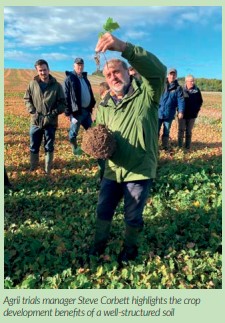
Plan The Move To Direct Drilling Carefully
Both cover crops and low-disturbance drilling are often seen as an easy way to improve soil health and performance
while also offering an opportunity to cut fixed costs. Where the transition is managed well, it can be very worthwhile
but in other cases, the journey to drilling nirvana can be a fraught with obstacles, explains Steve Corbett, trials
manager for crop advisers and research specialists, Agrii.“The move to reduced cultivations or pure direct drilling is about first recognising where systems can change while preserving or improving financial returns,” he says.
The first consideration, he believes, is to understand why the existing system is arranged as it is. “Systems are often soil dependant. There is a need to identify the characteristics of a seed drill that are important to the operation and the objectives set by the manager. Any pre-drilling activities should also be considered, be it straw raking or shallow cultivations. There are situations where moving the top centimetre or so of soil will be highly beneficial and others where it is not necessary,” Mr Corbett says
The development of new technology, especially the ability to apply inputs in a precise manner, and to incorporate more than one activity at a time, namely fertiliser placement and sowing of cover or companion crops, should also be considered.

“There are many facets to the direct drill conundrum. Do you want to apply fertiliser at the same time, and will you be sowing more than one crop too? This is before we consider the diversity of crops in the rotation, time of drilling, be it early or late autumn, or on cultivated or non-cultivated ground. As precision technology comes to play an ever-greater role, growers may also want to consider the potential to integrate variable rate systems. This often needs to be considered before we think about coulter travel or lift and how effectively the various setups can handle surface trash,” Mr Corbett says.
Soil type is often both the determining and limiting factor. It tells you what you have to work with and will define the scope of your objectives. For example, will it easily take water, is it easy to create a tilth, how much air will be displaced if we were to receive a heavy rain shower? From here, we can see what is and is not feasible.
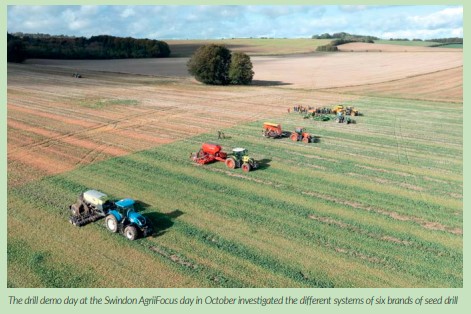
“At the basic level, soil type and condition will influence the choice between a disc or tine drill. These considerations rarely receive the time they warrant. Whether the disc runs at a slight angle with the coulter in its shadow or the disc is straight, and the coulter forces the opening will depend on the soil type and its condition. Issues such as hair-pinning, where the straw is forced into the opening, or where the opening can’t be closed after the seed has been placed because of the high plasticity of the soil, are often consequences of inappropriate drill choice or poor setup,” he says.
In a high weed pressure situation, especially black-grass, the considerations will be different again. There will be the desire to avoid bringing seed up to germination depth. In these situations, the minimal soil disturbance will be preferable. This would favour the Primera from Amazone or the Sabre tine from Weaving. In contrast, a winged tine is not suitable, but where more soil movement is desirable, the looser soil created by the likes of the Simtech or Cross-Slot allow for greater root development.
For many the move to direct drilling fits with the ‘re-generative’ movement, but it can take several seasons and a change to the system before the ground is properly ready to embrace the ‘re-gen ag’ philosophy. “It’s about earning the right to direct drill,” says Colin Lloyd. “Any drill in the wrong conditions will do a poor job and it concerns me that many growers are moving wholesale into direct drilling without first readying their ground. The transition phase is important as it paves the way for the drill that you have then chosen to fit your system,” he adds.
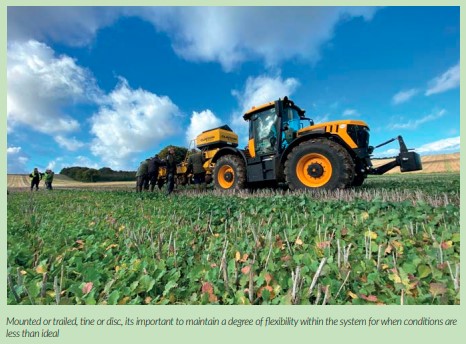
Manufacturers often make bold claims about details such as coulter pressure, but how much is enough, and do you really need masses of pressure? “Those with stiff, firm ground will need the ability to apply pressure, but where soils have been maintained in good friable order and compaction has been avoided, having the ability to apply 250kg of pressure per coulter is an expense that most can live without,” says Mr Lloyd. As efforts to improve soil biomass begin to deliver results, other design features become more important, such as the ability to deal with high quantities of material without becoming easily blocked.
“This is one reason why the Amazone Primera is popular with a section of growers. It has the size of frame and coulter arrangement to let material through. Other designs fail all to easily at this hurdle, especially if it is wet,” says Mr Corbett.
Having explored the available options, one of the last questions to be considered is: what happens if it comes wet?
“Most growers approach the purchase of a new drill from the perspective of wanting to do the job faster and more easily than before. Too often this comes at the cost of flexibility. “Most growers need at least two drills, probably a tine and disc, one of which may be a lightweight combination because it gives you the flexibility to go when conditions are less than ideal. Wet autumns are an increasing phenomenon, so systems need to be flexible otherwise performance suffers. It doesn’t mean you need to own it, but having access to a lightweight, mounted tine drill will often deliver the flexibility most growers require,” says Mr Corbett.
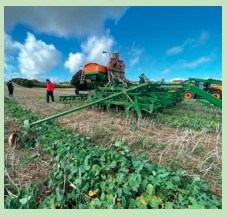
Profitability
Changing the system in expectation of financial improvements that aren’t then realised can be highly costly and stressful. To investigate this, Agrii has run long-term trials investigating the impact on performance from a system that seeks to balance cover crops and establishment regime across the rotation. “Few direct drilling advocates talk about yields or gross margin performance. Adopt the wrong approach for the situation or move faster than the transition will allow, and the impact to gross margins can be severe,” Mr Lloyd says.
A new seed drill won’t resolve a grassweed situation or increase biomass, so any system needs to first reflect the principles supporting good farming practices. “The condition of the ground, what are the mitigating circumstances, especially grassweed pressures, what crop and variety are you growing? These are the single biggest influence on performance.
“The Stow Longa rotations trial is in its seventh year; in the 2021 season we recorded a difference in winter wheat gross margin of £1,448/ha. This is partly due to a worsening grassweed problem, namely soft brome on a farm where this was not previously an issue, following five years of direct drilling in a section of the trial. The transition, especially on heavy land, must be managed with an understanding of the trade-offs,” Mr Lloyd says.
-

Farmer Focus – Julian Gold

I was not sorry to see the end of harvest 2021. A combination of low yielding OSR, a large acreage of Firefly wheat that broke down to Septoria, disappointing Extase yields and spring barley that was flattened by August rains meant that it was not a vintage year for us. Luckily prices have compensated to a large extent but it rams home the message that with potentially increasingly volatile weather patterns leading to less predictable harvest outcomes it is vitally important to minimise the reliance on purchased inputs and maximise the crop growth benefits to be had (free) from fully functioning natural ecosystems.
The input reduction message is especially pertinent with the present high Nitrogen prices. I have been uneasy for a long while about the high level of environmentally damaging Nitrogen inputs going onto my crops and advocate that minimising the use of synthetic N should be the fifth pillar of Regen. Ag. to sit alongside the other four that are usually quoted. Unfortunately as a Farm Manager tasked with maximising business profitability it has always been a difficult decision to unilaterally reduce fertiliser inputs and potential profit margins.
For a number of years now I have supported the idea of a Nitrogen tax or Quota (Tin hat on!) so that we are all on a level playing field, but the idea has never really gained any serious traction. The present high prices have however effectively done this in the short term and I am excited at the prospect of finally being able to grow our harvest 2022 crops with significantly lower N levels and the challenge of maximising N use efficiency, plant nutrition etc to compensate.
Our 10 m Kockerling tine drill continues to give us sterling service. It is particular good at coping with my masochistic tendency to plant crops behind silly amounts of chopped straw (particularly winter and spring barley) It also gives remarkably even establishment considering that it is rigid front to back and left to right with no contour following. (This is partly due to the fact that for most situations, apart from when we use it to direct drill OSR after wheat, we have used it after combining to create a shallow stale seedbed. This creates a “ bottom” to the seedbed and when we return to the field for the drilling pass there is virtually no tine chatter.).
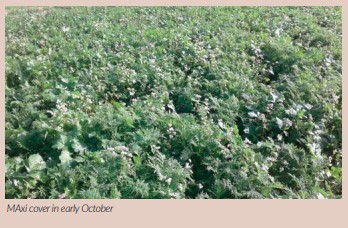
Unfortunately it moves a lot of soil so we get a second blackgrass chit during the drilling pass and even with a big pre-em stack we are not getting 100% control. Consequently we are not eradicating blackgrass but merely standing still with annoying levels which are not low enough to be hand roguable. For this reason and the fact that the drill doesn’t work so well in spring after cover crops I am convinced that we now need to purchase a low disturbance disc drill so that we have the capability to use discs or tines as appropriate. At this time of the year I am busy in the office doing budgets, cashflows and accounts analysis and my thoughts have been turning to other machinery investments that may be needed to help us move our farming system forwards and unfortunately it all comes to an eye watering amount of money!
In particular I have been pondering the techniques that will be needed if and when Glyphosate is banned and have come to the conclusion we will need a plough for occasional shallow rotational complete inversion.We will also need a shallow disc cultivator which will cut 100% of the soil surface at extremely shallow working depth to enable mechanical stale seedbed destruction. I also have a Hoe on my shopping list which will obviously allow mechanical weeding if weed resistance and loss of herbicides make this necessary.

More excitingly though it will allow us to continue to experiment with clover understoreys and could facilitate early planting of cover crops in late spring in growing cash crops during a last hoeing pass with a seeder unit on board. This last possibility is a particular interest for me : Our farming system relies on photosynthesis to build soil carbon (rather than manures or composts) and I am always painfully aware of the wasted sunshine during July, August and September. If we could establish cover crops in growing cereals in late spring they would hopefully germinate (if sowing timed effectively with rain events) and sit in the base of the crops ready to quickly grow after harvest when the competition is removed and therefore utilise the summer sunshine more effectively. It will probably need a fair bit of experimentation to work out the best species/species mix and may even involve the need to buy a stripper header if it results in a lot of green material in the base which interferes with a conventional header.
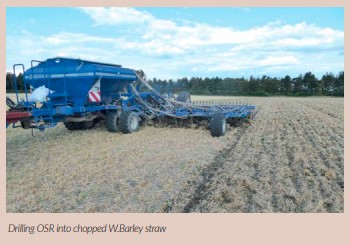
As I said it is all a big scary shopping list!
Meanwhile back in the fields I have been assessing the successes and failures of our ongoing Cover crop experimentation (Over the last 6-8 yrs we have tried virtually every species and combination of) Traditionally we have grown high biomass multi species mixes for sheep grazing but after the last two wet winters I think that poaching damage may be giving us negative yield affects in following direct drilled spring barley crops.I have therefore started to try lower biomass mixes in some fields that can be partially destroyed by frost/rolling instead of grazing. I have been very impressed this year with the Hutchinsons maxi cover mix which has a nice range of species and has provided a useful cover but which is already starting to die back after a couple of strong frosts recently.
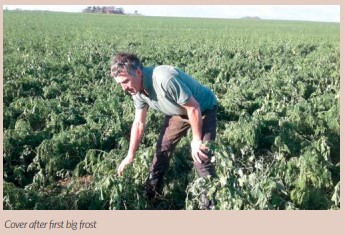
-

Drill Manufacturers In Focus…

Ryetec are participating in a in a long-term trial in conjunction with Luke Medd of Regennortheast. Luke is this year’s Agrii Innovation Award Winner, and at his farm in County Durham he is looking at ways to improve soil health and resilience.
On Luke’s farm at West Worley Hill, Co Durham, he and the local Agrii team have split two fields in half. One half of each field is being conventionally worked using a plough, power harrow and combination drill. The team is utilising a no till approach on the other half. But before they began, the team used the Agrii Soil Resilience Strategy to determine what the starting soil conditions were like. They carried out a full physical assessment and worked with Lancrop to analyse the soils’ overall nutrient status, biological health and carbon levels.
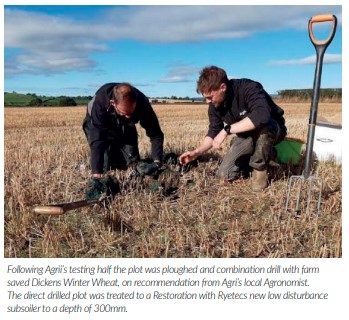

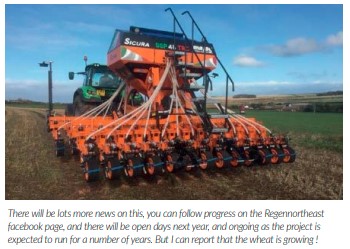
There will be lots more news on this, you can follow progress oIf you would like to keep up to date using the following links or search on Facebook:
www.facebook.com/Regenagnortheast
www.agrii.co.uk/blog/project-update-from-innovationaward-winner-luke-medd/

Plough Pan
The results from the Lancrop highlighted that a plough pan was present across all four plot sites. A plough pan is a hard, cementlike layer in the subsoil which prevents surplus water draining away freely and restricts root growth – it can be caused by ploughing regularly to the same depth. Which is why the team decided that the best option would be to carry out remedial works using a low-disturbance Ryetec Restorer subsoiler. The team are using the Agrii Soil Resilience Strategy and different cultivations to explore the question of how to ensure that soils are set up correctly for direct drilling.
-
Carbon In Soils: Why Farming For Carbon Should Be Encouraged
Written by Mike Abram
The British Society of Soil Science highlights both the benefits of farming for soil carbon, but also its limitations
to mitigate climate changeA new Science Note produced by the British Society of Soil Science suggests farmers should be encouraged and rewarded for implementing sustainable soil management or regenerative farming practices. But it also highlights some of the challenges in mitigating climate change through carbon farming. Soil contains more carbon than the atmosphere and plants combined, with the largest stocks found in peaty non-agricultural soils and uncultivated permanent pastures. In these stable ecosystems there is a balance between photosynthesis, which takes carbon dioxide from the air to be eventually converted to soil organic matter, and respiration, which releases it back to the atmosphere as carbon dioxide.
That means it is vital to protect these ecosystems by preventing any cultivation or other carbon-emitting land use change, the scientists say. In arable soils over time the carbon removed with harvested crops, and lost from soils through plant and microbial respiration has exceeded that added through photosynthesis and via carbon inputs, such as animal manures, composts and crop residues, leading to a gradual loss of soil organic matter. Cultivation and bare soils, in particular, have contributed to that imbalance. But this depletion can be reversed through land use change and sustainable soil management practices.
Significant long-term land use change converting arable land to grassland or woodland would have the biggest positive impact on soil organic carbon, but as the report says, it is unrealistic on a large scale because of the continued need to meet food security challenges. A more practical approach could be to include grass leys into arable rotations, which could result in a more sustainable system with healthier soil. However, the rotation’s productivity would be reduced with no human-edible crops during ley years, and, while long-term experiments at Rothamsted show there is a net increase soil organic content in arable ley rotations, there is more carbon cycling than in an all arable system, resulting in greenhouse gas emissions.
Integrating livestock could displace some edible crop production, which is not as efficient from a carbon perspective, emit more methane if ruminant numbers are not reduced elsewhere, while the change in soil carbon stocks is small compared with land use change. Other sustainable soil management that would have a potential positive benefit includes reducing tillage, incorporating cover crops or increasing carbon inputs such as manures and composts. While individually the changes are small, across a large area they add up, which is why there has been so much discussion about the possibility of mitigating climate change through soil carbon sequestration.
The scientists note that changes in soil organic carbon are slow to occur and difficult to measure, and often there is an overestimation of how much climate change mitigation is achievable – primarily because the quantity of carbon that can be stored in soil is finite. “Positive changes in soil management, or regenerative agricultural / agroecological practices, can cause soil organic carbon to increase over a period of decades until a new balance between carbon additions and carbon losses is achieved,” the science note says.
British Society of Soil Science soil
carbon recommendationsBased on the available scientific evidence, BSSS recommends that:
• The C stores in existing permanent grasslands, moorlands, peatlands, wetlands and woodlands are protected.
• SSM practices are more widely adopted to increase SOC, to help mitigate existing GHG emissions, to improve soil health and resilience, and to protect and enhance the multiple public goods and services provided by soil.
• Where financial incentives are developed to encourage SSM practices it is essential that funders provide ongoing support to these schemes. This recommendation applies equally to any scheme claiming C sequestration in soils.
• Soil C concentrations should be periodically monitored. While modelling can be used to estimate future C stocks in specific soils, it is essential that these estimates are validated through soil testing at a network of representative field sites.
• Sequestering C in soils and vegetation, although important, must not distract from the urgent need to reduce CO2 emissions from the burning of fossil fuels. Failure to address the latter will render the former irrelevant.
• Attempts to overcome natural soil C equilibria through application of materials such as rock dust or biochar must consider the whole life C costs of such practices as well as ensuring that they do not impact negatively on soil quality through pH change, chemical contamination or other undesirable characteristics.
The relatively large annual rates of carbon sequestration in the early years will eventually plateau, with carbon losses matching inputs, keeping the carbon balance at a new higher level. That new balance can only be maintained by continuation of favourable management practices. Sequestration is also reversible and can have unintended consequences. “For example, long-term application of organic manures can lead to excess nutrient supply and damage the quality of rivers, lakes and coastal waters.” Equally land use changes could result in deforestation and cultivation elsewhere to grow food that would have been produced on the land now being used for carbon sequestration.
This leads the authors to conclude that soil carbon sequestration, while offering a useful tool to tackle greenhouse gas emissions, cannot provide the single answer to climate change mitigation. It’s too slow, too easy to reverse and not of a large enough scale – implementing the most extreme land use changes would only account for 2-3% of UK greenhouse gas emissions, they say. Despite these risks, they do see scope for soil carbon sequestration to contribute, particularly on low C, degraded landscapes, albeit with a stark warning: “Sequestering C in soils and vegetation, although important, must not distract from the urgent need to reduce carbon dioxide emissions from the burning of fossil fuels. Failure to address the latter will render the former irrelevant.”
Where financial incentives are being developed to encourage sustainable soil management practices, they note the challenges of setting up robust monitoring, reporting and verification of soil carbon. It’s not just because of variations caused by climate, land use and management in different agro-climatic regions, but also because it can be difficult to determine the baseline soil carbon content against which to judge and pay for the success of sequestration. They note the different approaches being taken – some rely on soil sampling, others on sampling with process-based modelling, others on modelling and remote sensing. “Differences in the way carbon markets estimate sequestration make it difficult to be confident that climate benefits have been achieved,” the report warns.
Unfortunately, the costs associated with direct measurement of soil carbon make it impractical as a long-term monitoring option, meaning the authors suggest models and remote sensing are essential once a ground-truthed soil carbon baseline has been achieved. They also stress that the potential for future land management changes to re-release captured carbon means that monitoring must be robust for the lifetime of any payment scheme.
In conclusion, the British Society of Soil Science note says it is essential that historic soil organic carbon declines in the UK need to be addressed for soils to function effectively and be more resilient to weather events, but warns this requirement creates potential for abuse when governments, corporations and individuals are increasingly keen to offset their carbon emissions through sequestration initiatives.
Find the British Society of Soil Science note on the current understanding of research on soil carbon here: https://soils.org. uk/education/guidance-and-science-notes/
-

Red Tractor: Supporting Non-Assured Grain To Have Access To Feed Mills
Written by Steve Ridsdale, Arable Farmer

All eyes now on AIC and the
feed millsRed Tractor (RT) released a statement on 23rd November from Jim Moseley, chief executive of RT, saying “Red Tractor recognises and supports the principle for all UK growers to be free to choose which markets they access, whether they are assured or not”. This comes after a group of growers, who came together on The Farming Forum, started working together to highlight the fact that feed mills would only purchase UK produced grain if it was farm assured under a scheme such as RT or Scottish Quality Crops (SQC). These exact same feed mills do not request imported crops to have any farm level assurance when operating under the Agricultural Industries Confederation (AIC) Universal Feed Assurance Scheme (UFAS).
Representatives of the farmers requested a meeting with AHDB, which was held near Milton Keynes on 19th November, to discuss the unlevel playing field and how AHDB could help levy payers get fair market access which would no longer put them at a disadvantage to imported grain. It’s a crazy situation where our own industry has made it more difficult for our own farmers to access their own markets.
This is a market access issue, and it’s been voluntarily created by our industry leaders. The NFU have supported RT and AHDB have financially supported RT. UK Farmers now either have to pay to be in a farm assurance scheme, or they have their market access cut off. Farmers have been voting with their feet, and resigning their NFU membership over this single issue. As an industry we’re stronger together, so we need to quickly find a solution to this situation.
The RT statement went on to say
“We are urging the AIC to review and amend its scheme to create a route to market for non-assured domestic grain under FEMAS and its gatekeeper protocol. Equal opportunities to supply the UK’s assured animal fed market should be given to domestic farmers as is afforded to imported grain”.
If AIC agree to this change, farmers will not need to be members of an assurance scheme such as RT or SQC to supply combinable crops to a UFAS feed mill.
Mills And Market Access
There are 47,000 cereal producers in the UK, but only approximately 21,000 farmers in a recognised farm assurance scheme. As a result of this, less than half of UK cereal farmers are currently able to access the feed mill markets. Meanwhile, imports are literally able to sail in on a boat with no requirement to be farm level assured and get unfettered access to our feed mill markets. All eyes will now be on the AIC and the individual feed mills to see if they back the amendment to give UK growers equivalent market access, which is no more onerous than they expect of imports. It will be interesting to see if farmer owned mills respond differently to non-farmer owned, and if mills will consider the wishes of their owners and suppliers, some of which will also be their animal feed customers.
What Will the New Requirements Be?
We don’t yet know the answer to that question. The important point is the principle that RT have agreed that non-assured grain should be able to access feed mills. We now need to establish what will be required of UK grain. The safety of non-assured imports is checked via laboratory testing for parameters such as pesticide residues and heavy metal concentrations. This technique is designed to work for large shipments of grain, whereas a system for UK grain needs to be nimble enough to work for a 29-tonne load.
RT livestock scheme rules (e.g. beef and sheep or dairy) allow non-assured grain to be purchased provided it is accompanied by a grower declaration that grain is suitable for consumption by livestock and free from contaminants. As this declaration is both designed and accepted by RT, then this same declaration should also be acceptable for grain which is supplied to a feed mill, as it will ultimately be fed to the same RT assured livestock. The difference between the domestic grain and imported grain is that the domestic grain has been grown within the UK legislative framework, and thus should not be required to go through the laboratory testing procedure. It is for this same reason that RT assured grain is not required to undergo any laboratory safety testing.
Feed Grain and Human Consumption Grain
Imported combinable crops access human consumption markets as well as feed markets. Once the precedent has been set and a standard agreed for UK grain to access feed markets, then the same principles should apply to human consumption combinable crops. I would encourage processors to engage with AHDB Cereals & Oilseeds to help determine which standards they may like to see adhered to. One suggestion is to have a system designed to back up the grower’s declaration, so it would be more comprehensive than the currently accepted RT feed declaration if the customer required it to be so. This could hold real-time information such as the NSTS certificate number and expiry date, and it could have multiple tiers depending on if the farmer wished to only supply feed grains, or if the farmer wished to supply to human consumption markets.
1. Feed grain declaration. Grown to UK legislative standards.
2. Human consumption. Declaration backed up with real-time information (e.g. NSTS expiry date, grain drying and storage records, mycotoxin risk assessment etc.)
This would be a step-change in the way grain assurance could work. It only needs to hold food safety information, it would be cheaper and easier for farmers to comply with yet offer a better level of assurance due to the real time nature of the system.
Declarations
Audited assurance schemes essentially just check our self-declarations.
• Our mycotoxin risk assessment is self-declared.
• Our legally required pesticide application record is self-declared.
• The date we filled up our rodent bait stations is self-declared.
• The date we washed and disinfected our grain bucket is self-declared.
• The fertiliser spreader calibration record is self-declared.
We just have to pay a private company to tick a box, witnessing that we’ve self-declared something. This doesn’t alter the fact it was a selfdeclaration.
We can still self-declare our working practices and grain safety (just as RT currently allows for farm-to-farm grain trading) but we are unhappy paying a private company to simply check our self-declarations when our buyers are happy to purchase imported grain which does not have this on-farm requirement and associated costs. We already get DEFRA and Trading Standards on-farm checks. They check pesticide records, pesticide stores, grain handling and storage facilities and insist on a written and recorded HACCP protocol for grain drying and storage.
The Role Of AHDB
The creation and running of grain quality marks and schemes is within the remit of AHDB. We’ve asked AHDB if they will create a new system to help the 27,000 farmers who currently have no access to either feed or human consumption markets. We think information could be held on the digital passport framework, so it’s accessible and available to customers. We’ve also asked AHDB to consult with feed mills, human consumption mills, maltsters and oilseed crushers, as to how a new scheme could fulfil their grain assurance needs.
The farmers have done their bit in bringing this issue into the limelight. All eyes are now on our AHDB, AIC and the processors to implement a solution for levy payers.
-
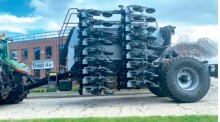
Importance Of Tyre Pressures
There can’t be too many farmers now who aren’t aware of the importance of tyre pressures and the advantages that can be gained from selecting the correct ones for the job at hand. Reducing soil compaction is the obvious benefit but testing proves that work rate, tyre life and fuel economy are all negatively impacted by using too high a pressure in the field. On the other hand safety, fuel consumption, tyre wear and comfort are all affected on the road if pressure is too low.
Being realistic, changing tyre pressures in the traditional way is time consuming and is very difficult in the field. As a result, most operators will pick a pressure in the middle to try and find a balance, resulting in a pressure that is never correct for either field work or road haulage. For optimum performance, tyre pressures should be chosen based on axle load, speed and ground conditions, so would vary for different operations and at different times of year. Modern high flexation tyres are capable of running very low pressures to maximise footprint and traction so there are big gains to be had if this new technology can be used.

We can now offer a practical solution to this issue, allowing the operator to select the correct pressures at the push of a button, whilst on the move. Our tyre inflation system has been developed specifically for fitment to agricultural vehicles and machinery. It can be installed on any make and model of tractor, trailer, tanker, drill, harvester etc, in fact anything with wheels! The system is supplied to many major manufacturers and is available as a retro-fit solution distributed and supported from our factory in East Yorkshire.
Air is supplied by the on board air brake compressor, or by an additional hydraulic driven compressor if additional inflation performance is needed. The system is controlled via the ISObus interface (or a separate control unit if ISObus is not available) and can be controlled using the joystick. The latest V10 software allows lots of new functionality and the ability to save multiple configurations of machine, implement, weights etc with the corresponding pressures as advised by your tyre manufacturer.
The system then controls air flow to the wheels using a set of valves mounted on the machine and transfers this to the wheels via rotating unions. These are mounted either in the centre of the wheels or, in the case of bar axle equipped tractors, around the axle itself, tucking pipework away on the inside of the wheel. If a trailer or tanker is getting a system installed there are options to pass the air through the axle itself, to keep things neater still.
Mounted in the wheel rim is an additional valve, fitted into a new large diameter hole to improve flow compared to the original tyre valve. The new valve closes automatically when the system isn’t changing pressures, ensuring that leaks don’t deflate the tyres. If necessary, the pipework over the mudguards can be detached with a quick release fitting and stored away up on the mudguard. This can be helpful in particularly tight spaces or in very muddy conditions but in normal use the lines would stay attached. If tyre repairs or changes are needed this happens as normal. Our CTIS system is compatible with dual wheels, either controlling both tyres on each side, or just the inner ones – allowing the outside wheels to be left at a low pressure at all times.

The time to change pressures depends on the compressor fitted and the tyres sizes being inflated, however typical tractor times would be 10-12 minutes to inflate from field to road, and a couple of minutes to go the other way. Inflation times can be reduced by fitting larger or additional compressors however the ability to continue driving means that no waiting is necessary while pressures are changed.
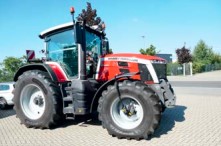
There has never been a better time to invest in CTIS, with systems being covered under the current Farming Investment Fund grant scheme. Grant number FETF109 will cover £2413 of funding towards a CTIS system – accounting for roughly 40% of the total cost. Applications to this scheme are through the Gov.uk website and must be in before January 7th 2022 to qualify.
To contact us with any questions or enquiries on 01482 576222 or via info@tractair.co.uk
You can also find more information and a link to the grant application page at our website – www.tractair.co.uk
-

Drill Manufacturers In Focus…
2021 has been a very positive year here at Simtech. A bulging order book, coupled
with a move towards producing everything we sell in the UK from our Suffolk
base, has not been without many challenges. Added to this is a complete re-design
of the entire pneumatic range, as well as some smaller changes to other models.
The main change to our pneumatic models is that we are now building our own hoppers, rather than buying in readymade assemblies, but we are still fitting the tried and tested Sulky metering and distribution system, that we have been using since launching our pneumatic range in 2012. However the configuration is now very different from previous models, with the distribution head now mounted at the rear of the hopper and much lower down for ease of access.
Calibration is now done by a front facing stainless steel chute, which directs the seed into a large bucket that is supplied with each drill. The same chute is also used to empty the hopper at the end of each job.
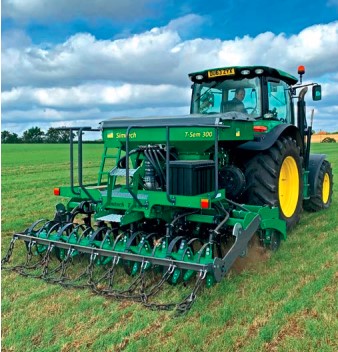
Hopper capacities remain at 1000 litres for the 3m model, but increase to 1300 litres for the 4m version and upwards to 1700 litres for the folding 4.8 & 6m machines. In addition we have placed the hoppers on all the drills as far forward as possible to minimise the weight on the back of the tractor. 3 & 4m models have a large platform area and lower level hopper for easier access and the new design height adjustable level sensor can be reached from the outside.
The big change to the folding models is a new design to allow the entire weight of the hopper/centre frame assembly to bear down onto the two drilling frames along their centrelines. This means that the whole weight of the drill is pushing down evenly across its entire width, but the 2 drilling frames can pivot along their individual centrelines to allow them to follow the ground contours. Added to this is a new simple system for adjusting depth, consisting of a spiral cam and a spring loaded plunger, which allows for 18 individual settings in its 0 to 10cm drilling depth range. With the exception of the 4m model, we have rolled out this new design across the whole T-Sem range.
Come and see us at Lamma 22 on stand 18.360, where we will be please to speak with you about our exciting new range and enable you to tap into our extensive experience on reducing tillage and converting to a more sustainable farming model.
-

Using Yield Monitor Data And Satellite Imagery To Inform Precision Management
With so much data captured on farm, making it useful can be like unlocking Pandora’s box. Researchers from Rothamsted Research – Kirsty Hassall, Alice Milne and Andy Whitmore – share how yield and satellite data can help with precision management in potato crops.

Modern technology allows farmers to vary inputs across fields, giving the potential for more profitable and environmentally friendly farming. To realise this potential, farmers need good information about the likely response of the crop at scales appropriate for management. The AHDB Rotations Partnership project is an integrated piece of research into soil and water management in agriculture. Through a combination of experimentation and data analysis, the project aims to develop and apply new technologies to help farmers manage their soil resource. To that end, the project incorporates work on the variability of soil and the role that precision management can play in enhancing productivity and profit with minimum impact on the environment
One of Rothamsted’s contributions is to investigate how farmers could make best use of the information captured by yield monitor data and satellite data and apply this knowledge within the context of precision management in potato crops.
What we have found so far
Yield monitor data is now collected as standard on many farms. In addition to this, processed satellite data, which is available at increasingly fine resolution, can be used to see how crop response varies within a field throughout the growing season. These sources of data offer a potential means to understand and predict the variation in crop response within fields.
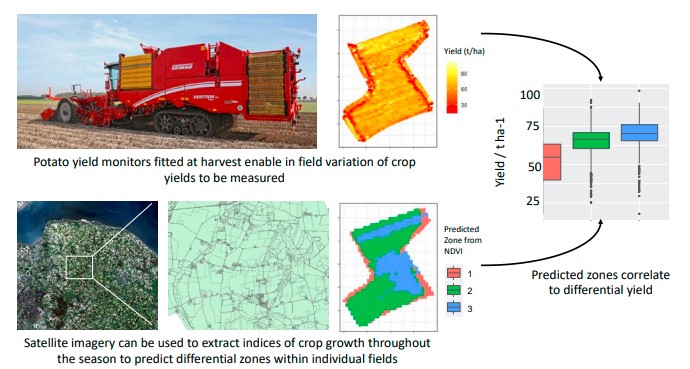
There are many sources of variation within a field; some are obvious, some are not. One of our first investigations was to see if we could detect some of the more obvious sources of variation from potato yield monitor data, specifically the presence of tramlines within potato fields. Indeed, we were able to demonstrate that despite the inherent variation associated with yield, it was possible to detect this patterning in the data, thus demonstrating that potato yield monitor data can be sensitive enough to pick up within-field features, such as yield losses associated with compaction around tramlines. This finding gave us confidence that these data can be used to identify other less tangible sources of variation within a field.
Further investigation was undertaken on the potential for yield monitor data to inform differential zones within a field for use in precision management. We developed spatially coherent clustering methods to identify zones within a field where points within each zone varied similarly to one another across seasons. In this type of analysis, we might pick up a zone that yields consistently better than the field average across seasons or one that consistently yields poorly. Importantly, by using data across multiple seasons, we are also able to identify zones that might be at risk from seasonal features. For instance, a zone that performs well in most years but particularly poorly in ‘abnormal years’ may be an area at risk of drought which is only apparent in particularly dry seasons.
How we account for the missing data
A key challenge to achieving the above is to obtain data across seasons for the same field. Given the long rotation of potato crops, typically, we only had a single year’s worth of data available. To predict zones in potato crops, we used yield monitor data from other crops in the rotation (where available) and also satellite NDVI data. To validate these predictions, we compared the identified zones with the observed potato yields. Over 50% of fields showed a good correspondence between predicted zones and observed yield. In some, the yield variation across the field was not great enough to detect, and in others, the variation in yield was driven by factors not detectable from crop yield or NDVI.
During the project, we had access to yield monitor data from a reasonable number of different fields and this motivated us to compare not only the average yield per hectare across fields, but also how the zones compared across all fields within the study. This adds a new level to yield benchmarking tools and potentially aids interpretation for farmer-led decisions.
Understanding and making use of the results
From a scientific perspective, our results were interesting, but the question remained: are the management zones informed by sensed data useful for variable-rate management? Our plan was to hold interviews with farmers to determine how our analysis could best serve their needs and to establish whether farmer knowledge could be scientifically integrated into the method of analysis. Like so many things in the past year, COVID-19 interfered with our plans, and so, instead, we conducted a small online survey with approximately 60 members of the industry about their motivations for variable-rate management and data and software needs.
Responses from the questionnaire suggested that the main motivation for potato farmers to adopt variable-rate management was to increase profit, closely followed by reducing impacts to the environment. The respondents believed that variable-rate management was most appropriate for fertiliser application, but irrigation and adjusting seed rate also ranked highly in the list of operations that should be managed differentially.
With respect to the use of management zones formed from sensed data, most respondents suggested interpretation would be best enhanced through their own expert knowledge of the field and additional maps of soil variation. Comparing yield metrics through a benchmarking tool was also seen as a helpful way to interpret and use management zones.
Would you like to take part?
Yield monitor data and satellite NDVI are undoubtedly of interest to farmers as they reveal variation in their fields. As with any project or research, in attempting to answer one question, we inevitably open up more. In the world of big data, we also need to find useful data to inform precision management, both in terms of profitability but also environmental sustainability.
A key source of useful information is yield monitor data, and the wider the coverage over different crops, regions of the UK and seasons, the wider the applicability of any findings.